User:Shakescene/Collaboration
| Timelines of World War II |
|---|
| Chronological |
| Prelude |
| By topic |
| By theatre |
In World War II, many governments, organizations and individuals collaborated with the Axis powers, "out of conviction, desperation, or under coercion."[1] Nationalists sometimes welcomed German or Italian troops, believing they brought liberation from colonization. The Vichy French, Danish, and Belgian governments attempted to appease or bargain with the invaders, in hopes of mitigating harm to their citizens and economies. Some countries cooperated with Italy and Germany because they wanted to regain territory lost during and after the First World War or which their nationalist citizens simply coveted. Others, such as France, already had strong fascist movements and/or anti-semitic sentiment, which the invaders validated and empowered. Individuals such as Hendrik Seyffardt in the Netherlands and Theodoros Pangalos in Greece saw collaboration as a path to power in their country. Others believed that Germany would prevail, and either wanted to be on the winning side, or feared being on the losing one.
Axis military forces recruited many volunteers, often with promises they later broke, or from among prisoners-of-war trying to escape appalling conditions in their camps. Other volunteers freely enlisted because they subscribed to Nazi or fascist ideology.
In France the term "collaborationist" was coined for those who collaborated for ideological reasons.[2] Bertram Gordon, a professor of modern history, also used the terms "collaborationist" and "collaborator" for ideological and non-ideological collaboration.[3] Elsewhere, "collaboration" described cooperation, sometimes passive, with a victorious power.[4]
Stanley Hoffmann saw collaboration as either involuntary, a reluctant recognition of necessity, or voluntary, opportunistic, or greedy. He also categorized collaborationism as "servile", attempting to be useful, or "ideological", full-throated advocacy of the occupier's ideology.[citation needed]
Collaboration in Western Europe[edit]
Belgium[edit]
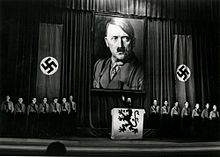
Belgium was invaded by Nazi Germany in May 1940[5] and remained under German occupation until the end of 1944.
Political collaboration took separate forms across the Belgian language divide. In Dutch-speaking Flanders, the Vlaamsch Nationaal Verbond (Flemish National Union or VNV), clearly authoritarian and anti-democratic from its beginnings, and influenced by fascist ideas elsewhere in Europe,[6] was part of the pre-war Flemish Movement, and became a major player in the German occupation strategy. VNV politicians were promoted to positions in the Belgian civil administration.[7] VNV and its comparatively moderate stance was increasingly eclipsed later in the war by the more radical and pro-German DeVlag movement.[8]
In French-speaking Wallonia, Léon Degrelle's Rexist Party, a pre-war authoritarian and Catholic Fascist political party,[9] became the VNV's Walloon equivalent, although Rex's Belgian nationalism put it at odds with the Flemish nationalism of VNV and the German Flamenpolitik. Rex became increasingly radical after 1941 and declared itself part of the Waffen-SS.
Although the pre-war Belgian government went into exile in 1940, the Belgian civil service remained in place for much of the occupation. The Committee of Secretaries-General, an administrative panel of civil servants, although conceived as a purely techocratic institution, has been accused of helping to implement German occupation policies. Despite its intention to mitigate harm to Belgians, it enabled but could not moderate German policies such as the persecution of Jews and deportation of workers to Germany, although it did manage to delay the latter to October 1942.[10] Encouraging the Germans to delegate tasks to the Committee allowed much more efficient implementation than could have been achieved by force.[11] Since Belgium depended on Germany for food imports, the committee was always at a disadvantage in negotiations.[11]
The Belgian government in exile criticized the committee for helping the Germans.[12][13] The Secretaries-General were also unpopular within Belgium itself. In 1942, the journalist Paul Struye described them as "the object of growing and almost unanimous unpopularity."[14] As the face of the German occupation authority, they became unpopular with the public, which blamed them for the German demands they implemented.[12]
After the war, several of the Secretaries-General were tried for collaboration. Most were quickly acquitted. Gérard Romsée, the former secretary-general for internal affairs, was sentenced to twenty years imprisonment, and Gaston Schuind, Judicial Police of Brussels,[15] was sentenced to five.[16] Many former secretaries-general had careers in politics after the war. Victor Leemans served as a senator from the centre-right Christian Social Party (PSC-CVP) and became president of the European Parliament.[17]
Belgian police have also been accused of collaborating, especially in the Holocaust.[8]
Towards the end of the war, militias of collaborationist parties actively carried out reprisals for resistance attacks or assassinations.[18] Those assassinations included leading figures suspected of resistance involvement or sympathy,[19] such as Alexandre Galopin, head of the Société Générale, assassinated in February 1944. Among the etaliatory massacres of civilians[18] was the Courcelles Massacre, in which 20 civilians were killed by the Rexist paramilitary for the assassination of a Burgomaster, and a massacre at Meensel-Kiezegem, where 67 were killed.[20]
Britain[edit]
Channel Islands[edit]
The Channel Islands were the only British territory in Europe occupied by Nazi Germany. The policy of the islands' governments was what they called "correct relations" with the German occupiers. There was no armed or violent resistance by islanders to the occupation.[21] After 1945 allegations of collaboration were investigated. In November 1946, the UK Home Secretary informed the UK House of Commons[22] that most allegations lacked substance. Only twelve cases of collaboration were considered for prosecution, and the Director of Public Prosecutions ruled them out for insufficient grounds. In particular, it was decided that there were no legal grounds for proceeding against those alleged to have informed the occupying authorities against their fellow citizens.[23]
On the islands of Jersey and Guernsey, laws[24][25] were passed to retrospectively confiscate the financial gains made by war profiteers and black marketeers, although these measures also affected those who had made legitimate profits during the years of military occupation.
During the occupation, many civiiians were aroused by women who fraternized with German soldiers aroused indignation. After the liberation, British soldiers had to intervene to prevent revenge attacks.[26]
Denmark[edit]
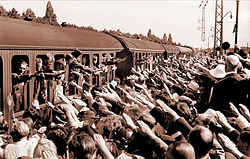
When on 9 April 1940, German forces invaded neutral Denmark, they violated a treaty of non-aggression signed the year before, but claimed they would "respect Danish sovereignty and territorial integrity, and neutrality."[27] The Danish government quickly surrendered and remained intact. The parliament maintained control over domestic policy.[28] Danish public opinion generally backed the new government, particularly after the Fall of France in June 1940.[29]
Denmark's government cooperated with the German occupiers until 1943,[citation needed] and helped organize sales of industrial and agricultural products to Germany.[30] The Danish government enacted a number of policies to satisfy Germany and retain the social order. Newspaper articles and news reports "which might jeopardize German-Danish relations" were outlawed[citation needed] and on 25 November 1941, Denmark joined the Anti-Comintern Pact.[31] The Danish government and King Christian X repeatedly discouraged sabotage and encouraged informing on the resistance movement. Resistance fighters were imprisoned or executed; after the war informants were sentenced to death.[32][33][34]
Prior to, during and after the war Denmark enforced a restrictive refugee policy; it handed over to German authorities at least 21 Jewish refugees who had managed to cross the border;[30] 18 of these people died in concentration camps, including a woman and her three children.[35] In 2005 prime minister Anders Fogh Rasmussen officially apologized for these policies.[36]
Following the German invasion of the Soviet Union on 22 June 1941, German authorities demanded the arrest of Danish communists. The Danish government complied, directing the police to arrest 339 communists listed on secret registers. Of these, 246, including the three communist members of the Danish parliament, were imprisoned in the Horserød camp, in violation of the Danish constitution. On 22 August 1941, the Danish parliament passed the Communist Law, outlawing the Communist Party of Denmark and also communist activities, in another violation of the Danish constitution. In 1943, about half of the imprisoned communists were transferred to Stutthof concentration camp, where 22 of them died.
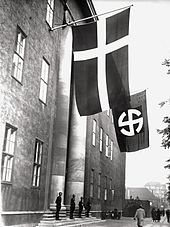
Industrial production and trade were, partly due to geopolitical reality and economic necessity, redirected towards Germany. Many government officials saw expanded trade with Germany as vital to maintaining social order in Denmark.[37] It was feared that increased unemployment and poverty could lead to civil unrest, resulting in a crackdown by the Germans.[38] Unemployment benefits could be denied if jobs were available in Germany, so an average of 20,000 Danes worked in German factories through the five years of the war.[39]
The Danish cabinet, however, rejected German demands for legislation discriminating against Denmark's Jewish minority. Demands for a death penalty were likewise rebuffed and so were demands to give German military courts jurisdiction over Danish citizens and for the transfer of Danish army units to the German military.[citation needed]
France[edit]

A hero for saving lives at Verdun in World War I, Marshal Philippe Pétain became the head (le Chef) of the post-democratic French State when the French Third Republic collapsed after a catastrophic French loss in the Battle of France.[40] Prime minister Paul Reynaud had resigned rather than sign the resulting armistice agreement. The National Assembly voted to have Pétain convoke a constituent assembly (constitutional convention), which he never did. The resulting authoritarian government[41] operated outside the bounds of the French constitution and was largely run by its ministers.
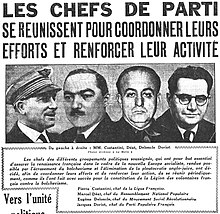
Pierre Laval and other Vichy prime ministers initially prioritized saving French lives and repatriating French prisoners of war. The illusion of autonomy was important to the Vichy cabinet, which wanted at costs to avoid direct rule by the German military government.
One lever of pressure by the German authorities in Paris was the implicit threat of replacing Vichy with several explicitly pro-Nazi parties and leaders (for example Marcel Déat and Jacques Doriot), who were permitted to operate and publish in the German-oOccupied zone, while criticising Vichy for insufficiently-enthusiastic cooperation with Germany. These parties collaborated in organising and recruiting the Legion of French Volunteers Against Bolshevism (LVF) to fight alongside German forces on the Eastern Front. The LVF was eventually succeeded, after massive losses and several changes, by the Waffen-SS's Charlemagne Division, who were among Berlin's final defenders in 1945. [42][43][44]

Recruiting French workers for German enterprises[edit]
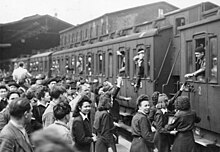
Vichy initially reached an agreement with Germany to recruit three French volunteers to work in German factories in exchange for every repatriated French prisoner-of-war, but when this scheme (la Relève) failed to draw enough workers to please the Reich, Vichy started conscripting Frenchmen into the Service du Travail Obligatoire (STO or obligatory labour service).
Many workers went into hiding or joined the French Resistance rather than report for the STO. This made the occupation personal to many young French people. Able-bodied French citizens who faced forced labor in Germany began instead to disappear into forests and mountain wildernesses to join the maquis (or rural Resistance).[45][46]
Vichy collaboration in the Holocaust[edit]

Long before the Occupation, France had had a history of native anti-Semitism and philo-Semitism, as seen in the controversy over the guilt of Alfred Dreyfus (from 1894 to 1906). It has thus been difficult for historians to establish how much of Vichy's anti-Semitic campaigns came from native French roots, how much from willing collaboration with the German occupiers and how much from simple (and sometimes reluctant) cooperation with Nazi instructions.
Pierre Laval was an important decision-maker in the extermination of Jews, the Porajmos (holocaust) of Roma people (Gypsies), and the extermination of other "undesirables." Following an increasingly restrictive series of anti-Semitic and anti-Masonic measures (initially concentrated on recent immigrants before French natives) such as the Second law on the status of Jews, Vichy opened a series of internment camps in France — such as one at Drancy — where Jews, Gypsies, homosexuals, and political opponents were interned.[47] The French police, directed by René Bousquet and under increasing German pressure, helped to deport 76,000 Jews (both directly and via the French camps) to the Nazi concentration and extermination camps.[48]
In 1995, President Jacques Chirac officially recognized the responsibility of the French state for the deportation of Jews during the war, in particular, the more than 13,000 victims, of whom only 2,500 survived, of the Vel' d'Hiv Roundup of July 1942, during which Laval had decided, of his own volition to deport children along with their parents.[49] The French police were also organized by Bousquet to work with the Gestapo in the massive Marseille roundup (rafle) that destroyed a whole neighbourhood in the Old Port.
Estimates of how many of France's Jews (about 300,000 at the start of the Occupation) died in the Holocaust range from about 60,000 (≅ 20%) to about 130,000 (≅ 43%).[50]
Aftermath[edit]

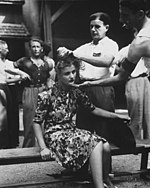
As the Liberation spread across France in 1944-45, so did the so-called Wild Purges (Épuration sauvage). Resistance groups took summary reprisals, especially against suspected informers and members of Vichy's anti-partisan, paramilitary, Milice. They would also join with local citizens to form unofficial courts that tried and punished thousands of people accused (sometimes unjustly) of collaborating and consorting with the enemy. Estimates of the numbers of victims differ, but historians agree that the number will never be fully known.[51]
Then, as General Charles de Gaulle and his allies gradually reimposed a formal legal order over France, the informal purges were replaced by l'Épuration légale (or legal purge), whose most notable, and most demanded, convictions were those of Pierre Laval, tried and executed in October 1945, and Marshal Philippe Pétain, tried, convicted, and sentenced to death in the summer of 1945, later commuted to life imprisonment on the Bréton island of Yeu, where he died in 1951.
Several decades later, a few surviving ex-collaborators such as Paul Touvier were tried for crimes against humanity. René Bousquet was rehabilitated and regained some influence in French politics, finance and journalism, but was nonetheless investigated in 1991 for deporting Jews. He was assassinated in 1993 just before his trial would have begun. Maurice Papon served as prefect of the Paris police under President de Gaulle (thus bearing ultimate responsibility for the Paris massacre of 1961) and, 20 years later, as Budget Minister under President Valéry Giscard d'Estaing, before Papon's 1998 conviction for crimes against humanity in organizing the deportation of 1,560 Jews from the Bordeaux region to the French internment camp at Drancy.
Other collaborators such as Émile Dewoitine also managed to have important roles after the war. Dewoitine was eventually named head of Aérospatiale, which created the Concorde airplane.
Luxembourg[edit]
Luxembourg was invaded by Nazi Germany in May 1940 and remained under German occupation until early 1945. Initially, the country was governed as a distinct region as the Germans prepared to assimilate its Germanic population into Germany itself. The Volksdeutsche Bewegung (VdB) was founded in Luxembourg in 1941 under the leadership of Damian Kratzenberg, a German teacher at the Athénée de Luxembourg.[52] It aimed to encourage the population towards a pro-German position, prior to outright annexation, using the slogan Heim ins Reich. In August 1942, Luxembourg was annexed into Nazi Germany, and Luxembourgish men were drafted into the German military.
Monaco[edit]
During the Nazi occupation of Monaco, the Monaco police arrested and turned over 42 Central European Jewish refugees to the Nazis while also protecting Monaco's own Jews.[53]
Netherlands[edit]

The Germans re-organized the pre-war Dutch police and established a new Communal Police, which helped Germans fight the country's resistance and to deport Jews. The National Socialist Movement in the Netherlands (NSB) had militia units, whose members were transferred to other paramilitaries like the Netherlands Landstorm or the Control Commando. A small number of people greatly assisted the German in their hunt for Jews, including some policemen and the Henneicke Column. Many of them were members of the NSB.[54] The column alone was responsible for the arrest of about 900 Jews.[55]
During the war, famous actor and singer Johannes Heesters made his career in Nazi Germany, befriending high-ranking Nazis such as Joseph Goebbels and living in houses stolen from wealthy Jews.[56][unreliable source?]
Norway[edit]
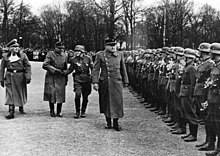
In Norway, the national government, headed by Vidkun Quisling, was installed by the Germans as a puppet regime during the German occupation, while king Haakon VII and the legally elected Norwegian government fled into exile.[57] Quisling encouraged Norwegians to volunteer for service in the Waffen-SS, collaborated in the deportation of Jews, and was responsible for the executions of members of the Norwegian resistance movement.
About 45,000 Norwegian collaborators joined the fascist party Nasjonal Samling (National Union), and about 8,500 of them enlisted in the Hirden collaborationist paramilitary organization. About 15,000 Norwegians volunteered on the Nazi side and 6,000 joined the Germanic SS. In addition, Norwegian police units like the Statspolitiet helped arrest many of Jews in Norway. All but 23 of the 742 Jews deported to concentration camps and death camps were murdered or died before the end of the war. Knut Rød, the Norwegian police officer most responsible for the arrest, detention and transfer of Jewish men, women and children to SS troops at Oslo harbour, was later acquitted during the legal purge in Norway after World War II in two highly publicized trials that remain controversial.[58]
Nasjonal Samling had very little support among the population at large[59] and Norway was one of few countries where resistance during World War II was widespread before the turning point of the war in 1942–43.[citation needed]
After the war, Quisling was executed by firing squad.[60] His name became an international eponym for "traitor".[61]
Collaboration in Eastern Europe[edit]
Albania[edit]
After the Italian invasion of Albania, the Royal Albanian Army, police and gendarmerie were amalgamated into the Italian armed forces in the newly created Italian protectorate of Albania.
The Albanian Fascist Militia formed after the Italian invasion of Albania in April 1939. In the Yugoslav part of Kosovo, it established the Vulnetari (or Kosovars), a volunteer militia of Kosovo Albanians. Vulnetari units often attacked ethnic Serbs and carried out raids against civilian targets.[62][63] They burned down hundreds of Serbian and Montenegrin villages, killed many people, and plundered the Kosovo and neighboring regions.[64]
Ethnic Albanian elements of the Italian armed forces participated in the Italian invasion of Greece and the German-led Axis invasion of Yugoslavia. After Italy capitulated, the Germans established police volunteer regiments and a national militia.[citation needed]
Baltic states[edit]
The three Baltic republics of Estonia, Latvia and Lithuania, first invaded by the Soviet Union, were later occupied by Germany and incorporated, together with the Byelorussian Soviet Socialist Republic of the U.S.S.R. (Belarus, see below), into Reichskommissariat Ostland.[65]
Estonia[edit]
In German plans, Estonia was to become an area for future German settlements, as Estonians themselves were considered high on the Nazi racial scale and as such had the potential for Germanization.[66] Unlike the other Baltic states, the seizure of Estonian territory by German troops was relatively long, from July 7 to December 2, 1941. This period was used by the Soviets to carry out a wave of repression against Estonians. It is estimated that the NKVD's subordinate Destruction battalions killed some 2,000 Estonian civilians,[67] and 50-60,000 people were deported deep into the USSR.[68] 10,000 of them died in the GULAG system within a year.[68] Many Estonians fought against Soviet troops on the German side, hoping to liberate their country. Some 12,000 Estonian partisans took part in the fighting.[69] Of great importance were the 57 Finnish-trained members of the Erna group, who operated behind enemy lines.[69]
Resistance groups were organised by Germans in August 1941 into the Omakaitse (lit. 'Self-defence'), which had between 34,000[70] and 40,000 members,[71] mainly based on the Kaitseliit, dissolved by the Soviets.[70] Omakaitse was in charge of clearing the German army's rear of Red Army soldiers, NKVD members, and Communist activists. Within a year its members killed 5,500 Estonian residents.[72] Later, they performed guard duty and fought Soviet partisans flown into Estonia.[72] From among Omakaitse members were recruited Estonian policemen, members of the Estonian Auxiliary Police and officers of the Estonian 20th Waffen-SS Division.[73]
The Germans formed a puppet government, the Estonian Self-Administration, headed by Hjalmar Mäe. This government had considerable autonomy in internal affairs, such as filling police posts.[73] The Security Police in Estonia (SiPo) had a mixed Estonian-German structure (139 Germans and 873 Estonians) and was formally under the Estonian Self-Administration.[74] Estonian police cooperated with Germans in rounding up Jews, Roma, communists and those deemed enemies of existing order or asocial elements. The police also helped to conscript Estonians for forced labor and military service under German command.[75] Most of the small population of Estonian Jews fled before the Germans arrived, with only about a thousand remaining. All of them were arrested by Estonian police and executed by Omakaitse.[76] Members of the Estonian Auxiliary Police and 20th Waffen-SS Division also executed Jewish prisoners sent to concentration and labor camps established by the Germans on Estonian territory.[77]
Immediately after entering Estonia, the Germans began forming volunteer Estonian units the size of a battalion. By January 1942, six Security Groups (battalions No. 181-186, about 4,000 men) had been formed and were subordinate to the Wermacht 18th Army.[78] After the one-year contract expired, some volunteers transferred to the Waffen-SS or returned to civilian life, and three Eastern Battalions (No. 658-660) were formed from those who remained.[78] They fought until early 1944, after which their members transferred to the 20th Waffen-SS Division.[78]
Beginning in September 1941, the SS and police command created four Infantry Defence Battalions (No. 37-40) and a reserve and sapper battalion (No. 41-42), which were operationally subordinate to the Wermacht. From 1943 they were called Police Battalions, with 3,000 serving in them.[78] In 1944 they were transformed into two infantry battalions and evacuated to Germany in the fall of 1944, where they were incorporated into the 20th Waffen-SS Division.[78]
In the fall of 1941, the Germans also formed eight police battalions (No. 29-36), of which only Battalion No. 36 had a typically military purpose. However, due to shortages, most of them were sent to the front near Leningrad,[79] and were mostly disbanded in 1943. That same year, the SS and police command created five new Security and Defense Battalions (they inherited No. 29-33 and had more than 2,600 men).[80] In the spring of 1943, five Defence Battalions (No. 286-290) were established as compulsory military service units. The 290th Battalion consisted of Estonian Russians. Battalions No. 286, 288 and 289 were used to fight partisans in Belarus.[81]
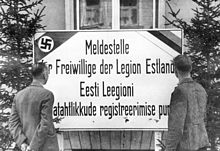
On Aug. 28, 1942, the Germans formed the volunteer Estonian Waffen-SS Legion. Of the approximately 1,000 volunteers, 800 were incorporated into Battalion Narva and sent to Ukraine in the spring of 1943.[82] Due to the shrinking number of volunteers, in February 1943 the Germans introduced compulsory conscription in Estonia. Born between 1919 and 1924 faced the choice of going to work in Germany, joining the Waffen-SS or Estonian auxiliary battalions. 5,000 joined the Estonian Waffen-SS Legion, which was reorganized into the 3rd Estonian Waffen-SS Brigade.[81]
As the Red Army advanced, a general mobilization was announced, officially supported by Estonia's last Prime Minister Jüri Uluots. By April 1944, 38,000 Estonians had been drafted. Some went into the 3rd Waffen-SS Brigade, which was enlarged to division size (20th Waffen-SS Division: 10 battalions, more than 15,000 men in the summer of 1944) and also incorporated most of the already existing Estionian units (mostly Eastern Battalions).[83] Younger men were conscripted into other Waffen-SS units. From the rest, six Border Defense Regiments and four Police Fusilier Battalions (Nos. 286, 288, 291, and 292).[84]
The Estonian Security Police and SD,[85] the 286th, 287th and 288th Estonian Auxiliary Police battalions, and 2.5–3% of the Estonian Omakaitse (Home Guard) militia units (between 1,000 and 1,200 men) took part in rounding up, guarding or killing of 400–1,000 Roma and 6,000 Jews in concentration camps in the Pskov region of Russia and the Jägala, Vaivara, Klooga and Lagedi concentration camps in Estonia.
Guarded by these units, 15,000 Soviet POWs died in Estonia: some through neglect and mistreatment and some by execution.[86]
Latvia[edit]
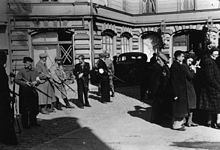
Deportations and murders of Latvians by the Soviet NKVD reached their peak in the days before the capture of Soviet-occupied Riga by German forces.[87] Those that the NKVD could not deport before the Germans arrived were shot at the Central Prison.[87] RSHA's instructions to their agents to unleash pogroms fell on fertile ground.[87] After the Einsatzkommando 1a and part of Einsatzkommando 2 entered the Latvian capital,[88] Einsatzgruppe A's commander Franz Walter Stahlecker made contact with Viktors Arājs on 1 July and instructed him to set up a commando unit. It was later named Latvian Auxiliary Police or Arajs Kommandos.[89] The members, far-right students and former officers were all volunteers, and free to leave at any time.[89]
The next day, 2 July, Stahlecker instructed Arājs to have the Arājs Kommandos unleash pogroms that looked spontaneous,[87] before the German occupation authorities were properly established.[90] Einsatzkommando-influenced[91] mobs of former members of Pērkonkrusts and other extreme right-wing groups began pillaging and making mass arrests, and killed 300 to 400 Riga Jews. Killings continued under the supervision of SS Brigadeführer Walter Stahlecker, until more than 2,700 Jews had died.[87][90]
The activities of the Einsatzkommando were constrained after the full establishment of the German occupation authority, after which the SS made use of select units of native recruits.[88] German General Wilhelm Ullersperger and Voldemārs Veiss, a well known Latvian nationalist, appealed to the population in a radio address to attack "internal enemies". During the next few months, the Latvian Auxiliary Security Police primarily focused on killing Jews, Communists and Red Army stragglers in Latvia and in neighbouring Byelorussia.[89]
In February–March 1943, eight Latvian battalions took part in the punitive anti-partisan Operation Winterzauber near the Belarus–Latvia border, which resulted in 439 burned villages, 10,000 to 12,000 deaths, and over 7,000 taken for forced labor or imprisoned at the Salaspils concentration camp.[92] This group alone killed almost half of Latvia's Jewish population,[93] about 26,000 Jews, mainly in November and December 1941.[94]
The creation of the Arājs Kommando was "one of the most significant inventions of the early Holocaust",[93] and marked a transition from German-organised pogroms to systematic killing of Jews by local volunteers (former army officers, policemen, students, and Aizsargi).[90] This helped with a chronic German personnel shortage and provided the Germans with relief from the psychological stress of routinely murdering civilians.[90] By the autumn of 1941, the SS had deployed the Latvian Auxiliary Police battalions to Leningrad, where they were consolidated into the 2nd Latvian SS Infantry Brigade.[95] In 1943, this brigade, which later became the 19th Waffen Grenadier Division of the SS (2nd Latvian), was consolidated with the 15th Waffen Grenadier Division of the SS (1st Latvian) to become the Latvian Legion.[95] Although the Latvian Legion was a formally volunteer Waffen-SS unit, it was voluntary only in name; approximately 80–85% of its men were conscripts.[96]
Lithuania[edit]

Prior to the German invasion, some leaders in Lithuania and in exile believed Germany would grant the country autonomy, as they had the Slovak Republic. The German intelligence service Abwehr believed that it controlled the Lithuanian Activist Front, a pro-German organization based at the Lithuanian embassy in Berlin.[97] Lithuanians formed the Provisional Government of Lithuania on their own initiative, but Germany did not recognize it diplomatically, or allow Lithuanian ambassador Kazys Škirpa to become prime minister, instead actively thwarting his activities. The provisional government disbanded, since it had no power and it had become clear that the Germans came as occupiers not liberators from Soviet occupation, as initially thought.
Units under Algirdas Klimaitis and supervised by SS Brigadeführer Walter Stahlecker started pogroms in and around Kaunas on 25 June 1941.[98][99] Lithuanian collaborators killed hundreds of thousands of Jews, Poles and Gypsies.[100][101][102] According to Lithuanian-American scholar Saulius Sužiedėlis, an increasingly antisemitic atmosphere clouded Lithuanian society, and antisemitic LAF émigrés "needed little prodding from 'foreign influences'".[103] He concluded that Lithuanian collaboration was "a significant help in facilitating all phases of the genocidal program . . . [and that] the local administration contributed, at times with zeal, to the destruction of Lithuanian Jewry".[104] Elsewhere, Sužiedėlis similarly emphasised that Lithuania's "moral and political leadership failed in 1941, and that thousands of Lithuanians participated in the Holocaust",[105] though he warned that "[u]ntil buttressed by reliable accounts providing time, place and at least an approximate number of victims, claims of large-scale pogroms before the advent of the German forces must be treated with caution".[106]
In 1941, the Lithuanian Security Police was created, subordinate to Nazi Germany's Security Police and Criminal Police.[107] Of the 26 Lithuanian Auxiliary Police Battalions, 10 were involved in the Holocaust.[clarification needed] On August 16, the head of the Lithuanian police, Vytautas Reivytis, ordered the arrest of Jewish men and women with Bolshevik activities: "In reality, it was a sign to kill everyone."[108] The Special SD and German Security Police Squad in Vilnius killed 70,000 Jews in Paneriai and other places.[107][clarification needed] In Minsk, the 2nd Battalion shot about 9,000 Soviet prisoners of war, and in Slutsk it massacred 5,000 Jews.
In March 1942, in Poland, the 2nd Lithuanian Battalion guarded the Majdanek concentration camp.[109] In July 1942, the 2nd Battalion participated in the deportation of Jews from the Warsaw Ghetto to Treblinka extermination camp.[110] In August–October 1942, some of the Lithuanian police battalions were in Belarus and Ukraine: the 3rd in Molodechno, the 4th in Donetsk, the 7th in Vinnytsa, the 11th in Korosten, the 16th in Dnepropetrovsk, the 254th in Poltava and the 255th in Mogilev (Belarus).[111] One battalion was also used to put down the Warsaw Ghetto Uprising in 1943.[109]
The participation of the local populace was a key factor in the Holocaust in Nazi-occupied Lithuania[112] which resulted in the near total decimation of Lithuanian Jews[a] living in the Nazi-occupied Lithuanian territories that would. From 25 July 1941, participation was under the Generalbezirk Litauen of Reichskommissariat Ostland. Out of approximately 210,000[113] Jews, (208,000 according to the Lithuanian pre-war statistical data)[114] an estimated 195,000–196,000 perished before the end of World War II (wider estimates are sometimes published); most from June to December 1941.[113][115] The events happening in the USSR's western regions occupied by Nazi Germany in the first weeks after the German invasion (including Lithuania – see map) marked the sharp intensification of the Holocaust.[116][117][118]
Bulgaria[edit]
Bulgaria was interested in acquiring Thessalonica and western Macedonia and hoped to gain the allegiance of the 80,000 Slavs who lived there at the time.[119] The appearance of Greek partisans there persuaded Axis forces to allow the formation of Ohrana collaborationist detachments.[119] The organization initially recruited 1,000 to 3,000 armed men from the Slavophone community that lived in the western part of Greek Macedonia.[120]
Czechoslovakia[edit]
Bohemia and Moravia (the Czech lands)[edit]
When the Germans annexed Czechoslovakia in 1938 and 1939, they created the Protectorate of Bohemia and Moravia from the Czech part of pre-war Czechoslovakia[121] It had its own military forces, including a 12-battalion 'government army', police and gendarmerie. The majority of the 'government army' was sent to Northern Italy in 1944 as labourers and guard troops.[122] Whether or not the government army can be considered a collaborationist force has been debated. Its commanding officer, Jaroslav Eminger, was tried and acquitted on charges of collaboration following World War II.[123] Some members of the force engaged in active resistance operations while in the army, and, in the waning days of the conflict, elements of the army joined in the Prague uprising.[124]
Slovak Republic[edit]
The Slovak Republic (Slovenská Republika) was a quasi-independent ethnic Slovak state which existed from 14 March 1939 to 8 May 1945 as an ally and client state of Nazi Germany. The Slovak Republic existed on roughly the same territory as present-day Slovakia (except for the southern and eastern parts). It bordered Germany, the Protectorate of Bohemia and Moravia, German-occupied Poland, and Hungary.[citation needed]
Greece[edit]
Germany put a Nazi government in place in Greece. Prime ministers Georgios Tsolakoglou, Konstantinos Logothetopoulos and Ioannis Rallis[125] all cooperated with Axis authorities. Greece exported agricultural products, especially tobacco, to Germany, and Greek "volunteers" worked in German factories.[126]
The collaborationist government created armed paramilitary forces such as the Security Battalions[127] to fight the EAM/ELAS resistance[128] Former dictator General Theodoros Pangalos saw the Security Battalions as a way to make a political comeback, and most of the Hellenic Army officers recruited in April 1943 were republicans in some way associated with Pangalos.[129]
Greek National-Socialist parties like George S. Mercouris' Greek National Socialist Party of the ESPO organization, or such openly anti-semitic organisations as the National Union of Greece, helped German authorities fight the Greek resistance, and identify and deport Greek Jews.[130] The BUND Organization and its leader Aginor Giannopoulos trained a battalion of Greek volunteers who fought in SS and Brandenburgers units.
During the Axis occupation, a number of Cham Albanians set up their own administration and militia in Thesprotia, Greece, under the Balli Kombëtar organization, and actively collaborated with first Italian and then German occupation forces, committing a number of atrocities.[131][unreliable source?] In one incident on 29 September 1943, Nuri and Mazzar Dino, Albanian paramilitary leaders, instigated the mass execution of all Greek officials and notables in Paramythia.[132]
An Aromanian political and paramilitary force, the Roman Legion, led by Aromanian nationalists Alcibiades Diamandi and Nicolaos Matussis, also collaborated with Italian forces.[citation needed]
Hungary[edit]
In April 1941, in order to regain territory and under German pressure, Hungary allowed the Wehrmacht across its territory in the invasion of Yugoslavia. Hungarian prime minister Pál Teleki wanted to maintain a pro-Allies neutral stance,[133] but could no longer stay out of the war. British Foreign Secretary Anthony Eden threatened to break diplomatic relations if Hungary did not actively resist the passage of German troops across its territory. General Henrik Werth, chief of the Hungarian General Staff, made a private arrangement with the German High Command, unsanctioned by the Hungarian government, to transport German troops across Hungary. Teleki, unable to stop these events, committed suicide on April 3, 1941.[133] After the war the Hungarian People's Court sentenced Werth to death for war crimes.[134]
Hungary joined the war on April 11, after the proclamation of the Independent State of Croatia.[citation needed]
It is not clear whether the 10,000–20,000 Jewish refugees (from Poland and elsewhere) were counted in the January 1941 census. They, and about 20,000 people who could not prove legal residency since 1850, were deported to southern Poland. According to Nazi German reports, a total of 23,600 Jews were murdered, including 16,000 who had earlier been expelled from Hungary[135] between July 15 and August 12, 1941, and either abandoned there or handed over to the Germans. In practice, the Hungarians deported many people whose families had lived in the area for generations. In some cases, applications for residency permits were allowed to pile up without action by Hungarian officials until after the deportations had been carried out. The vast majority (16,000) of those deported were massacred in the Kamianets-Podilskyi massacre at the end of August.[136][a]
In the massacres in Újvidék (Novi Sad) and nearby villages, 2,550–2,850 Serbs, 700–1,250 Jews and 60–130 others were murdered by the Hungarian Army and "Csendőrség" (gendarmerie) in January 1942. Those responsible, Ferenc Feketehalmy-Czeydner, Márton Zöldy, József Grassy, László Deák and others, were later tried in Budapest in December 1943 and sentenced, but some escaped to Germany.[citation needed]
During the war, Jews were called up to serve in unarmed "labour service" (munkaszolgálat) units which repaired bombed railroads, built airports or cleaned up minefields at the front barehanded. Approximately 42,000 Jewish labour service troops were killed on the Soviet front in 1942–43, of whom about 40% perished in Soviet POW camps.[citation needed] Many died as a result of harsh conditions on the Eastern Front and cruel treatment by their Hungarian sergeants and officers. Another 4,000 forced laborers died in the copper mines of Bor, Serbia. But Miklós Kállay, prime minister beginning on March 9, 1942, and Regent Miklós Horthy refused to allow the deportation of Hungarian Jews to German extermination camps in occupied Poland. This lasted until German troops occupied Hungary and forced Horthy to oust Kállay.[citation needed]
Following the German occupation of Hungary on March 19, 1944, Jews from the provinces were deported to the Auschwitz concentration camp; between May and July that year, 437,000 Jews were sent there from Hungary, most of them gassed on arrival.[140]
Poland[edit]
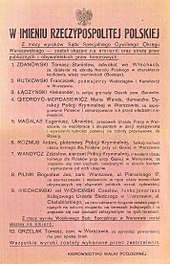
Unlike most German-occupied European countries, occupied Poland did not have a collaborationist government.[141][142] The Polish government did not surrender,[143] but instead moved into exile, first in France, then in London, while evacuating the armed forces via Romania and Hungary and by sea to allied France and Great Britain.[144][145][146] German-occupied Polish territory was either annexed outright by Nazi Germany or placed under German administration as the General Government.[147]
Shortly after the German Invasion of Poland in September 1939, the Nazi authorities ordered the mobilization of prewar Polish officials and the Polish police (the Blue Police), who were ordered to report for duty under threat of the "severest penalty".[148][149][150] Apart from serving as a regular police force dealing with criminal activities, the Blue Police was used by the Germans also to combat smuggling and resistance, to round up (łapanka) random civilians for forced labor, and to apprehend Jews (German: Judenjagd, "hunting Jews")[151] and participate in their extermination. Polish policemen were instrumental in implementing the Nazi policy of centralising Jews in ghettos and, from 1942 onwards, liquidating the ghettos.[152] In the late autumn and early winter of 1941, shooting Jews, including women and children, became one of their many activities at the orders of the German occupiers.[153] After an initial phase of hesitation, Polish policemen became familiar with Nazi brutality and, according to Jan Grabowski, in many cases even "surpassed their German teachers."[154] While many officials and police followed German orders, some acted as agents for the Polish resistance.[155][156]
Some of the collaborators – szmalcowniks – blackmailed Jews and their Polish rescuers and acted as informers, turning in Jews and Poles who hid them, and reporting on the Polish resistance.[157] Many prewar Polish citizens of German descent voluntarily declared themselves Volksdeutsche ("ethnic Germans"), and some of them committed atrocities against the Polish population and organized large-scale looting of property.[158][159]
The Germans set up Jewish-run governing bodies in Jewish communities and ghettos – Judenrat (Jewish council) that served as self-enforcing intermediaries for managing Jewish communities and ghettos; and Jewish Ghetto Police (Jüdischer Ordnungsdienst), which functioned as auxiliary police forces tasked with maintaining order and combating crime.[160]
The Polish Underground State's wartime Underground courts investigated 17,000 Poles who collaborated with the Germans; about 3,500 were sentenced to death.[161][162]
Romania[edit]
- See also Responsibility for the Holocaust (Romania), Antonescu and the Holocaust, Porajmos#Persecution in other Axis countries.
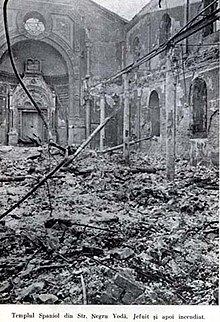
According to an international commission report released by the Romanian government in 2004, between 280,000 and 380,000 Jews died on Romanian soil, in the war zones of Bessarabia, Bukovina, and in territories formerly occupied by Soviets that came under Romanian control (Transnistria Governorate). Of the 25,000 Romani deported to concentration camps in Transnistria, 11,000 died.[163]
Though much of the killing was committed in the war zone by Romanian and German troops, in the Iaşi pogrom of June 1941 over 13,000 Jews died in trains traveling back and forth across the countryside.[164]
Half of the estimated 270,000 to 320,000 Jews living in Bessarabia, Bukovina, and Dorohoi County were murdered or died between June 1941 and the spring of 1944. Of these, between 45,000 and 60,000 Jews were killed in Bessarabia and Bukovina by Romanian and German troops[165][166] within months of the entry of the country into the war during 1941. Even after the initial killings, Jews in Moldavia, Bukovina and Bessarabia were subject to frequent pogroms, and were concentrated into ghettos from which they were sent to camps in Transnistria built and run by the Romanian authorities.[citation needed]
Romanian soldiers and gendarmes also worked with the Einsatzkommandos, German killing squads, tasked with massacring Jews and Roma in conquered territories, the local Ukrainian militia, and the SS squads of local Ukrainian Germans (Sonderkommando Russland and Selbstschutz). Romanian troops were in large part responsible for the 1941 Odessa massacre, in which from October 18, 1941 to mid-March 1942 Romanian soldiers, gendarmes and police, killed up to 25,000 Jews and deported more than 35,000.[163]
The lowest respectable mortality estimates run to about 250,000 Jews and 11,000 Roma in these eastern regions.[citation needed]
Nonetheless, half of the Jews living within the pre-Barbarossa borders survived the war, although they were subject to a wide range of harsh conditions, including forced labor, financial penalties, and discriminatory laws. All Jewish property was nationalized.
A report commissioned and accepted by the Romanian government in 2004 on the Holocaust concluded:[163]
Of all the allies of Nazi Germany, Romania bears responsibility for the deaths of more Jews than any country other than Germany itself. The murders committed in Iasi, Odessa, Bogdanovka, Domanovka, and Peciora, for example, were among the most hideous murders committed against Jews anywhere during the Holocaust. Romania committed genocide against the Jews. The survival of Jews in some parts of the country does not alter this reality.
Yugoslavia[edit]
On 25 March 1941, under considerable pressure, the Yugoslav government agreed to the signing of the Tripartite Pact with Nazi Germany, guaranteeing Yugoslavia's neutrality. The agreement was extremely unpopular in Serbia and led to massive street demonstrations.[167] Two days later, on 27 March, Serb military officers led by general Dušan Simović overthrew the regency and placed 17-year-old King Peter on the throne.[168] Furious at the temerity of the Serbs, Hitler ordered the invasion of Yugoslavia.[169] On 6 April 1941, without a declaration of war, combined German and Italian military armies invaded. Eleven days later Yugoslavia capitulated and was subsequently partitioned among the Axis states.[170]
The Central Serbia region and the Banat were subjected to German military occupation in the Territory of the Military Commander in Serbia, Italian forces occupied the Dalmatian coast and Montenegro; Albania annexed the Kosovo region and part of Macedonia; Bulgaria received Vardar Macedonia (today's North Macedonia); Hungary occupied and annexed the Bačka and Baranya regions as well as Međimurje and Prekmurje; the rest of Drava Banovina (roughly present-day Slovenia) was divided between Germany and Italy; Croatia, Syrmia and Bosnia were combined into the Independent State of Croatia, a puppet state under the direction of Croatian fascist Ante Pavelić.[171]
Territory of the Military Commander in Serbia[edit]

Serbia was placed under German military occupation, at first directly administered by Nazis, then under a puppet government led by General Milan Nedić.[172] The main function of the government was to maintain internal order, under the authority of the German Command, with the use of local paramilitary units.[173] The Wehrmacht Operations Staff never considered raising a unit to serve in the German armed forces.[174] By mid 1943, the collaborationist forces in Serbia, (Serbian and ethnic Russian units), numbered between 25,000 and 30,000.[174][175]
Serbian units[edit]
Serbian collaborationist organizations the Serbian State Guard (SDS) and the Serbian Border Guard (SGS) reached a combined 21,000 men at their peak. The Serbian Volunteers Corps (SDK), the party militia of the fascist Yugoslav National Movement led by Dimitrije Ljotić, reached 9,886 men; its members helped guard and run concentration camps and fought the Yugoslav Partisans and the Chetniks alongside the Germans. In October 1941, the Serbian Volunteer Corps participated in the Kragujevac massacre, arresting and delivering hostages to the Wehrmacht.[176] The members of the Serbian Volunteer Corps had to take an oath stating that they would fight to death against both Communists and Chetniks.[174]
Collaborationist Belgrade Special Police helped German units round up Jewish citizens for deportation to concentration camps. By the summer of 1942, most Serbian Jews had been exterminated.[177] By the end of 1942 the Special Police had 240 agents and 878 police guards under the command of the Gestapo.[175] After the liberation of the country in October 1944, the collaborationist forces retreated with the German army and were later absorbed into the Waffen-SS.[178]
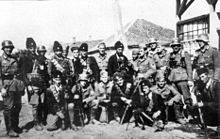
Almost from the start, two rival guerrilla movements, the Chetniks and the Partisans, engaged in a bloody civil war with each other, in addition to fighting against the occupying forces. Some Chetniks collaborated with the Axis occupation to fight the rival Partisan resistance, whom they viewed as their primary enemy, by establishing modus vivendi or operating as "legalised" auxiliary forces under Axis control.[179][180][181][182]
In August 1941 Kosta Pećanac put himself and his Chetniks at the disposal of Milan Nedić's government, becoming the occupation regime's ‘legal Chetniks'.[183] At the peak of their strength in mid-May 1942, the two legal Chetnik auxiliary forces numbered 13,400 men; these detachments were dissolved by the end of 1942.[174] Pećanac was captured and executed by forces loyal to his Chetnik rival Draža Mihailović in 1944. As no single Chetnik organization existed,[183] other Chetnik units engaged independently in marginal[184] resistance activities and avoided accommodations with the enemy.[179][185] Over a period of time, and in different parts of the country, some Chetnik groups were drawn progressively[184][186] into opportunist agreements: first with the Nedić forces in Serbia, then with the Italians in occupied Dalmatia and Montenegro, with some of the Ustaše forces in northern Bosnia, and after the Italian capitulation, also with the Germans directly.[187] In some regions Chetniks collaborated "extensively and systematically", which they called "using the enemy".[187][188][189]
Ethnic Russian units[edit]
The Auxiliary Police Troop and the Russian Protective Corps were paramilitary units raised in the German-occupied territory of Serbia, composed exclusively of anti-communist White émigrés or Volksdeutsche from Russia, under the command of General Mikhail Skorodumov (around 400 and 7,500 men respectively by December 1942).[190] The force reached a peak size of 11,197 by September 1944.[191] Unlike the Serbian units, the Russian Protective Corps was part of the German armed forces and its members took the Hitler Oath.[174]
Banat[edit]

Between April 1941 and October 1944, the Serbian half of the Banat was under German military occupation as an administrative unit of the Territory of the Military Commander in Serbia. Its daily administration and security were left up to its 120,000 Volksdeutsche, who represented 20% of the local population. In the Banat, security, anti-partisan warfare, and border patrols, were exclusively carried out by the Volksdeutsche in the Deutsche Mannschaft. In 1941, the Banat Auxiliary Police force was created to serve in concentration camps. It had 1,553 members by February 1942.[192] It was affiliated with the Ordnungspolizei and included some 400 Hungarians. The Gestapo in the Banat employed local ethnic Germans as agents. Banat Jews were deported and exterminated with the full participation of the Banat German leadership, the Banat Police and many ethnic German civilians.[192]
According to German sources, as of 28 December 1943, the Volksdeutsche minority of the Banat had contributed 21,516 men to the Waffen SS, the auxiliary police, and the Banat police.[170]
The 700,000 Volksdeutsche who lived in Yugoslavia[193] were the basis for the 7th SS Volunteer Mountain Division Prinz Eugen, which towards the war's end included other ethnicities. The division's soldiers brutally punished civilians accused of working with partisans in both occupied Serbia and the Independent State of Croatia, going so far as to raze entire villages.[194]
Josip Broz Tito, leader of the post-war Communist regime, nullified the rights of ethnic Germans, seized all of their property and expelled hundreds of thousands without a fair trial.
Montenegro[edit]
The Italian governorate of Montenegro was established as an Italian protectorate with the support of Montenegrin separatists known as Greens. The Lovćen Brigade, the militia of the Greens, collaborated with the Italians. Other collaborationist units included local Chetniks, police, gendarmerie and Sandžak Muslim militia.[195]
Kosovo[edit]
Most of Kosovo and the western part of southern Serbia (Juzna Srbija, included in Zeta Banovina) was annexed to Albania by fascist Italy and Nazi Germany.[196] Kosovar Albanians were recruited into Albanian paramilitary groups known as the Vulnetari, set up to assist Italian fascists maintain order,[197] many Serbs and Jews were expelled from Kosovo and sent to internment camps in Albania.[198][page needed]
The Balli Kombëtar militias, or Ballistas, were volunteer Albanian nationalistic groups that started as a resistance movement, then collaborated with the Axis Powers in hopes of seeing Greater Albania created.[199] Military units were formed within the militias, among them the Kosovo Regiment, raised in Kosovska Mitrovica as a Nazi auxiliary military unit after Italian capitulation.[200][page needed] According to German reports, in early 1944 some 20,000 Albanian guerrillas led by Xhafer Deva fought the Partisans alongside the Wehrmacht in Albania and Kosovo.[170]
Macedonia[edit]
In Bulgaria-annexed Vardar Macedonia, the occupation authority organized the Ohrana into auxiliary security forces. On 11 March 1943, Skopje's entire Jewish population was deported to the gas chambers of Treblinka concentration camp.[201]
Slovene Lands[edit]
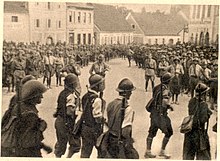
The Axis powers divided the Slovene Lands into three zones. Germany occupied the largest, northern part. Italy annexed the southern part, and Hungary annexed the northeast part, Prekmurje.[202] As in the rest of Yugoslavia, the Nazis used the Slovene Volksdeutsche to further their aims, in groups like the Deutsche Jugend (German Youth) which was used as an auxiliary military force for guard duty and fighting the partisans, and the Slovenian National Defense Corps.[202]
The Slovene Home Guard (Domobranci) was a collaborationist force formed in September 1943 in the Province of Ljubljana (then a part of Italy). It was led by former general Leon Rupnik but had limited autonomy, and at first, functioned as an auxiliary police force that assisted the Germans in anti-partisan actions.[203] Later, it gained more autonomy and conducted most of the anti-partisan operations in Ljubljana. Much of the Guard's equipment was Italian (confiscated when Italy dropped out of the war in 1943), although German weapons and equipment were used as well, especially later in the war. Similar, but much smaller units, were also formed in the Littoral (Primorska) and Upper Carniola (Gorenjska). The Blue Guard, also known as the Slovene Chetniks, was an anti-communist militia led by Karl Novak and Ivan Prezelj.[204]
The Anti-Communist Volunteer Militia (MVAC), was under Italian authority. One of the biggest components of the MVAC was the Civic Guards (Vaške Straže),[203] a Slovene volunteer military organization formed by the Italian Fascist authorities to fight the partisans, as well as some collaborationist Chetniks units. The Legion of Death (Legija Smrti), was another Slovene anti-partisan armed unit formed after the Blue Guard joined the MVAC.[202]
Independent State of Croatia[edit]
On 10 April 1941, a few days before Yugoslavia's capitulation, Ante Pavelić's Independent State of Croatia (NDH) was established as an Axis-affiliated state, with Zagreb as capital.[205] Between 1941 and 1945, the fascist Ustaše regime collaborated with Nazi Germany, and engaged in independent persecution. According to the United States Holocaust Memorial Museum, this resulted in the murder of approximately 30,000 Jews, between 25,000 and 30,000 Roma, and between 320,000 and 340,000 ethnic Serb residents of Croatia and Bosnia,[206] in camps like the infamous Jasenovac concentration camp.[207][208]
The 13th Waffen Mountain Division of the SS Handschar (1st Croatian), created in February 1943, and the 23rd Waffen Mountain Division of the SS Kama (2nd Croatian), created in January 1944, were manned by Croats and Bosniaks as well as local Germans. Earlier in the war, Pavelić formed a Croatian Legion for the Eastern Front and attached it to the Wehrmacht. Volunteer pilots joined the Luftwaffe as Pavelić did not want to get his army directly involved for both propaganda reasons (Domobrans/Home Guards were a "chieftain of Croatian values, never attacking and only defending") and due to a safeguarding need for political flexibility with the Soviet Union.
Pavelić proclaimed that Croats were the descendants of Goths, to eliminate the leadership's inferiority complex and be better viewed by the Germans. The Poglavnik stated that "Croats are not Slavs, but Germanic by blood and race".[209] Nazi German leadership was indifferent to this claim.[citation needed]
Bosnian Muslims[edit]
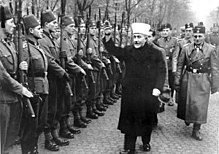
In 1941 Bosnia became an integral part of the Independent State of Croatia. Bosnian Muslims were considered Croats of Islamic confession.[210]
Collaboration with the U.S.S.R. and on Soviet territory[edit]
1939–1941[edit]
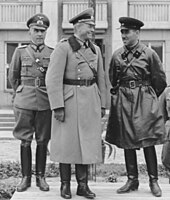
During the invasion of Poland and Western Europe in 1939, the Soviet Union presented a friendly stance towards Germany with a joint military parade, several German–Soviet commercial agreements and Gestapo–NKVD conferences on suppressing resistance in the occupied territories.
After 1941[edit]
Following the Operation Barbarossa, Germany occupied large areas of the western Soviet Union, parts of which remained under German control until late 1944.
The Waffen-SS recruited from many nationalities living in the Soviet Union, and the German government attempted to enroll Soviet citizens voluntarily for the Ostarbeiter program. Originally this effort worked well, but the news of the terrible conditions faced by workers dried up the flow of new volunteers and the program became forcible.[211]
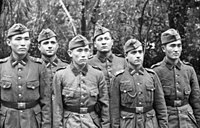
"Turkestan Legion"[edit]
Although Turkic peoples were initially seen as "racially inferior" by the Nazis, this changed in autumn 1941. Given the difficulties of their invasion of the Soviet Union, the Nazis attempted to harness the anti-Russian sentiment of Turkic peoples in the Soviet Union. The first Turkestan Legion was mobilized in May 1942.
The Ostlegionen contained between 275,000 and 350,000 "Muslim and Caucasian" volunteers and conscripts.[212]
Russia[edit]

In Russia proper, ethnic Russians governed the semi-autonomous Lokot Autonomy in Nazi-occupied Russia.[213] On 22 June 1943, a parade of the Wehrmacht and Russian collaborationist forces was welcomed and positively received in Pskov. The entry of Germans into Pskov was labelled "Liberation day" by occupying authorities, and the old Russian tricolor flag was included in the parade.[214]
Kalmykians[edit]
The Kalmykian Cavalry Corps was composed of about 5,000 Kalmyks who chose to join the retreating Germans in 1942 rather than remain in Kalmykia as the German Army retreated before the Red Army.[215] Joseph Stalin subsequently declared the Kalmyk population as a whole to be German collaborators in 1943 and ordered mass deportations to Siberia, causing great loss of life.[216]
Ukraine[edit]


Before World War II, the territory of present-day Ukraine was divided primarily between the Ukrainian SSR of the Soviet Union and the Second Polish Republic. Smaller regions were part of Romania and Hungary.
Soviet policies implemented in the 1930s were still fresh in the memory of Ukrainians. These included the Holodomor of 1932–33, the Great Purge (1937–38) that included the persecution of intellectuals during, the massacre of Ukrainian intellectuals after the annexation of Western Ukraine from Poland in 1939, and the introduction and implementation of collectivization that impoverished Ukrainian farmers.[217][218][219]
The Ukrainians also remembered that their country's brief independence from 1917 to 1920 was helped by a treaty with the Central Powers and intervention by German forces.[220]
During the period of occupation, Nazi-controlled Ukrainian newspaper Volhyn wrote that
"The element that settled our cities (Jews) ... must disappear completely from our cities. The Jewish problem is already in the process of being solved.[221]
Some Ukrainian collaborationist organizations participated in the Holocaust. The Ukrainian Auxiliary Police solicited the 1941 Babi Yar massacre of Kiev's Jewish population.[222][223][224] Sonderkommando 4a and the 45th Battalion of the German Order Police conducted the shootings. Servicemen of the 303rd Battalion of the German Order Police at this time guarded the outer perimeter of the execution site.[225][226][227]
On 18 September 1941 in Zhytomyr, 3,145 Jews were murdered with the assistance of the Ukrainian People's Militsiya (Operational Report 106). In Korosten, Ukrainian militia rounded up 238 Jews for liquidation (Operational Report 80) and carried out the killings by themselves[228] similar to Sokal, where on 30 June 1941 they arrested and executed 183 Jews. At times, the assistance was more active.[229] Operational Report 88 stated that on 6 September 1941, for example, 1,107 Jewish adults were shot by the German forces while the Ukrainian militia unit assisting them liquidated 561 Jewish children and youths.[230]
On 28 April 1943, German Command announced the establishment of the 14th Waffen Grenadier Division of the SS (1st Galician).[231] An estimated 83,000 people volunteered for service in the Division.[232] The Division was used in anti-partisan operations in Poland, Czechoslovakia and Yugoslavia, and in the fight against the Soviet forces during the Brody offensive and Vienna offensive. Those that survived surrendered to the Allies and the bulk emigrated to the West, primarily England, Australia and Canada.[citation needed]
Some Ukrainians participated in the suppression of the Warsaw Ghetto Uprising of 1943[233][failed verification] and the Warsaw Uprising of 1944, where a mixed force of German SS troops, which included Russians, Cossacks, Azeris and Ukrainians, backed by German regular army units, killed up to 40,000 civilians.[234][235]
The German high command estimated that there were 180,000 Ukrainian volunteers serving with units scattered all over Europe and proposed to merge them into a single force. The Ukrainian Liberation Army (Ukrainian: Українське Визвольне Військо, Ukrainske Vyzvolne Viisko, UVV) was formed by the German Army in 1943 to collect them together.
Belarus[edit]
In Byelorussia under German occupation, local pro-independence politicians attempted to use the Nazis to re-establish an independent Belarusian state, which was conquered by the Bolsheviks in 1919. A Belarusian representative body, the Belarusian Central Council, was created under German control in 1943 but had no real power and concentrated mainly on managing social issues and education. Belarusian national military units (the Byelorussian Home Defence) were only created a few months before the end of the German occupation.
Many Belarusian collaborators retreated with German forces in the wake of the Red Army advance. In January 1945, the 30th Waffen Grenadier Division of the SS (1st Belarussian) was formed from the remains of Belarusian military units. The division participated in a small number of battles in France but demonstrated active disloyalty to the Nazis and saw mass desertion.[citation needed]
Transcaucasia[edit]

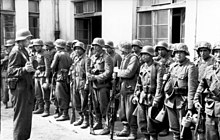
Ethnic Armenian, Georgian, Turkic and Caucasian forces deployed by the Germans consisted primarily of Soviet Red Army POWs assembled into ill-trained legions.[citation needed] Among these battalions were 18,000 Armenians, 13,000 Azerbaijanis, 14,000 Georgians, and 10,000 men from the "North Caucasus."[236] American historian Alexander Dallin notes that the Armenian and Georgian Legions were sent to the Netherlands as a result of Hitler's distrust of them, and many later deserted.[237] Author Christopher Ailsby called the Turkic and Caucasian forces formed by the Germans "poorly armed, trained and motivated", and "unreliable and next to useless".[236]
The Armenian Revolutionary Federation (the Dashnaks) was suppressed in Armenia when the First Republic of Armenia was conquered by the Russian Bolsheviks in the 1920 Red Army invasion of Armenia and thus ceased to exist. During World War II, some of the Dashnaks saw an opportunity to regain Armenia's independence. The Armenian Legion under Drastamat Kanayan participated in the occupation of the Crimean Peninsula and the Caucasus.[238][239] On 15 December 1942, the Armenian National Council was granted official recognition by Alfred Rosenberg, the Reich Ministry for the Occupied Eastern Territories. The president of the Council was Ardasher Abeghian, its vice-president was Abraham Guilkhandanian, and it numbered among its members Garegin Nzhdeh and Vahan Papazian. Until the end of 1944, the organization published a weekly journal, Armenian, edited by Viken Shantn, who also broadcast on Radio Berlin with the aid of Dr. Paul Rohrbach.[240]
Collaboration beyond Europe with the European Axis powers[edit]
Egypt and the Palestine Mandate[edit]
The well-publicized Arab-Jewish clash in Mandatory Palestine from 1936 to 1939, and the rise of Nazi Germany, began to affect Jewish relations with Egyptian society, despite the fact that the number of active Zionists was small.[241] Local militant and nationalistic societies, like the Young Egypt Party and the Society of Muslim Brothers, circulated reports claiming that Jews and the British were destroying holy places in Jerusalem, and other false reports that hundreds of Arab women and children were being killed.[242][undue weight? ] Some of this antisemitism was fueled by an association between Hitler's regime and anti-imperialist Arab activists. One activist, Haj Amin al-Husseini, received Nazi funds for the Muslim Brotherhood to print and distribute thousands of anti-Semitic propaganda pamphlets.[242]
In the 1940s the situation worsened. Sporadic pogroms began in 1942.[undue weight? ]
French colonial empire[edit]
France retained its colonial empire, and the terms of the armistice shifted the balance of power of France's reduced military resources away from metropolitan France and towards its overseas possesions, especially French North Africa. Although in 1940, most French colonies except for the French Equatorial Africa had rallied to Vichy France, this changed during the war. By 1943, all French colonies, except for Japanese-controlled French Indochina, were under the control of the Free French.[243] French Equatorial Africa in particular played a key role.[244]
French North Africa[edit]
Concerned that the French fleet might fall into German hands, the British Royal Navy sank or disabled most of it in the July 1940 attack on the Algerian naval port at Mers-el-Kébir, killing over a thousand French sailors.[245]
When Operation Torch, the Allied invasion of French North Africa, began on 8 November 1942 with landings in Morocco and Algeria, Vichy forces initially resisted, killing 479 and wounding 720. Admiral François Darlan appointed himself High Commissioner of France (head of civil government) for North and West Africa, then ordered Vichy forces there to stop resisting and co-operate with the Allies, which they did.[246][247][page needed]

Most Vichy figures were arrested, including Darlan and General Alphonse Juin,[248] chief commander in North Africa. Both were released, and US General Dwight D. Eisenhower accepted Darlan's his self-appointment. This infuriated de Gaulle, and he refused to recognise Darlan. Darlan was assassinated on Christmas Eve 1942 by a French monarchist.
German Wehrmacht forces in North Africa established the Kommando Deutsch-Arabische Truppen, composed of two battalions of Arab volunteers of Tunisian origin, an Algerian battalion and a Moroccan battalion.[249] The four units had total of 3,000 men; with German cadres.[250]
Morocco[edit]
In 1940, Résident Général Charles Noguès implemented antisemitic decrees coming from Vichy excluding Jews working as doctors, lawyers or teachers.[251][252][253] All Jews living elsewhere were required to move to the Jewish quarters, called mellahs,[251] Vichy anti-semitic propaganda encouraged boycotting Jews,[251] and pamphlets were pinned to Jewish shops.[251] These laws put Moroccan Jews in an uncomfortable position "between an indifferent Muslim majority and an antisemitic settler class."[252]
Sultan Mohammed V reportedly refused to sign off on "Vichy's plan to ghettoize and deport Morocco's quarter of a million Jews to the killing factories of Europe," and, in an act of defiance, insisted on inviting all the rabbis of Morocco to the 1941 throne celebrations.[254]
Tunisia[edit]
Many Tunisians took satisfaction in France's defeat by Germany in June 1940,[255] but little else. Despite his commitment to ending the French protectorate, the pragmatic independence leader Habib Bourguiba abhorred the Axis state ideologies.[256] and feared any short-term benefit would come at the cost of long-term tragedy.[256]
After the Second Armistice at Compiègne, Pétain sent a new Resident-General to Tunis, Admiral Jean-Pierre Esteva. The arrests followed of Taieb Slim and Habib Thameur, central figures in the Neo-Destour party.
Bey Muhammad VII al-Munsif moved towards greater independence in 1942, but when the Free French forced out the Axis powers in 1943, they accused him of collaborating with Vichy and deposed him.
French Equatorial Africa[edit]
The federation of colonies in French Equatorial Africa (AEF or Afrique-Équatoriale française) rallied to the cause of De Gaulle after Félix Éboué of Chad joined him in August 1940. The exception was Gabon, which remained Vichy French until 12 November 1940, when it surrendered to the invading Free French. The federation became the strategic centre of Free French activities in Africa.
Syria and the Lebanon (League of Nations mandates)[edit]
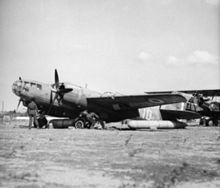
The Vichy government's Armée du Levant (Army of the Levant) under General Henri Dentz had regular metropolitan colonial troops and troupes spéciales (special troops, indigenous Syrian and Lebanese soldiers).[257] Dentz had seven infantry battalions of regular French troops at his disposal, and eleven infantry battalions of "special troops", including at least 5,000 cavalry in horsed and motorized units, two artillery groups and supporting units.[257] The French had 90 tanks (according to British estimates), the Armée de l'air had 90 aircraft (increasing to 289 aircraft after reinforcement) and the Marine nationale (French Navy) had two destroyers,a sloop and three submarines.[258][259]
The Royal Air Force attacked the airfield at Palmyra, in central Syria, on 14 May 1941, after a reconnaissance mission spotted German and Italian aircraft. Attacks against German and Italian aircraft staging through Syria continued: Vichy French forces shot down a Blenheim bomber on 28 May, killing the crew, and forced down another on 2 June.[260] French Morane-Saulnier M.S.406 fighters also escorted German Junkers Ju 52 aircraft into Iraq on 28 May.[260] Germany permitted French aircraft en route from Algeria to Syria to fly over Axis-controlled territory and refuel at the German-controlled Eleusina air base in Greece.[261]
After the Armistice of Saint Jean d'Acre, on 14 July 1941, 37,736 Vichy French prisoners of war survived, who mostly chose to be repatriated rather than join the Free French.
Foreign military volunteers[edit]
Although official Nazi policy barred non-Germans from joining the regular German army, volunteers from many countries were permitted to join the Waffen-SS and the auxiliary police (Schutzmannschaft). Overall, nearly 600,000 Waffen-SS members were non-German,[citation needed] and some countries such as Belgium and the Netherlands contributed thousands of volunteers.[citation needed]
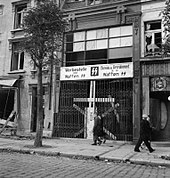
France[edit]
Various collaborationalist parties in occupied France and the unoccupied Vichy zone assisted in establishing the Legion of French Volunteers Against Bolshevism. These volunteers initially counted some 10,000 volunteers and later evolved, after heavy casualties, into the Charlemagne Division, one of the first SS divisions composed mostly of foreigners and among the last military units to defend Berlin in 1945.[42][43][44]
British India[edit]
The Indian Legion (Legion Freies Indien, Indische Freiwilligen Infanterie Regiment 950 or Indische Freiwilligen-Legion der Waffen-SS) was created in August 1942, recruiting chiefly from disaffected British Indian Army prisoners of war captured by Axis forces in the North African campaign. Most were supporters of the exiled nationalist and former president of the Indian National Congress Subhas Chandra Bose. The Royal Italian Army formed a similar unit of Indian prisoners of war, the Battaglione Azad Hindoustan. (A Japanese-supported puppet state, Azad Hind, was also established in far-eastern India with the Indian National Army as its military force.)[262][263]
Non-German volunteer divisions of the Waffen-SS[edit]
Following is a list of the 18 largest Waffen-SS divisions composed mostly or entirely of foreign volunteers (note that there were other foreign Waffen-SS divisions composed mostly of forced conscripts).[citation needed]
By the end of World War II, 60% of the Waffen-SS was made up of non-German volunteers from occupied countries.[citation needed] The predominantly Scandinavian 11th SS Volunteer Panzergrenadier Division Nordland division along with remnants of French, Italian, Spanish and Dutch volunteers were the last defenders of the Reichstag in Berlin.[264][265]
The Nuremberg Trials, in declaring the Waffen-SS a criminal organisation, explicitly excluded conscripts, who had committed no crimes.[266] In 1950, The U.S. High Commission in Germany and the U.S. Displaced Persons Commission clarified the U.S. position on the Baltic Waffen-SS Units, considering them distinct from the German SS in purpose, ideology, activities and qualifications for membership.
Volunteer auxiliary police units[edit]
Apart from frontline units, volunteers also played an important role in the large Schutzmannschaft police auxiliary units in the German-occupied territories in Eastern Europe. After the start of Operation Barbarossa in June 1941, recruitment of local forces began almost immediately, mostly at the orders of Heinrich Himmler. These forces were not members of the regular armed forces and were not intended for frontline duty, but were instead used for rear echelon activities, including maintaining the peace, fighting partisans, acting as police and organizing supplies for the front lines. In the later years of the war, members of these units numbered almost 200,000.
Business collaboration[edit]
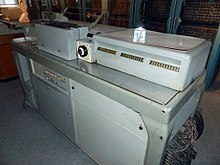
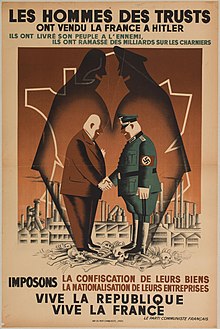
A number of international companies have been accused of having collaborated with Nazi Germany before their home countries' entry into World War II, though it has been debated whether the term "collaboration" is applicable to business dealings outside the context of overt war.[267][who?]
American companies that had dealings with Nazi Germany included Ford Motor Company,[268] Coca-Cola,[269][270] and IBM.[271][unreliable source?][272][273]
Brown Brothers Harriman & Co. acted for German tycoon Fritz Thyssen, who helped finance Hitler's rise to power.[274] The Associated Press (AP) supplied images for a propaganda book called The Jews in the USA, and another titled The Subhuman.[275]
In December 1941, when the United States entered the war against Germany, 250 American firms owned more than $450 million of German assets.[276] Major American companies with investments in Germany included General Motors, Standard Oil, IT&T, Singer, International Harvester, Eastman Kodak, Gillette, Coca-Cola, Kraft, Westinghouse, and United Fruit.[276] Many major Hollywood studios have also been accused of collaboration, in making or adjusting films to Nazi tastes prior to the U.S. entry into the war.[267]
German financial operations worldwide were facilitated by banks such as the Bank for International Settlements, Chase and Morgan, and Union Banking Corporation.[276]
Robert A. Rosenbaum writes: "American companies had every reason to know that the Nazi regime was using IG Farben and other cartels as weapons of economic warfare"; and he noted that
"as the US entered the war, it found that some technologies or resources could not be procured, because they were forfeited by American companies as part of business deals with their German counterparts."[277]
After the war, some of those companies reabsorbed their temporarily detached German subsidiaries, and even received compensation for war damages from the Allied governments.[276]
See also[edit]
- Blue Division
- Collaborationism
- Collaboration: Japanese Agents and Local Elites in Wartime China
- Finland in World War II
- German-occupied Europe
- Italian Civil War
- International Commission for the Evaluation of the Crimes of the Nazi and Soviet Occupation Regimes in Lithuania
- List of Allied traitors during World War II
- Molotov–Ribbentrop Pact
- Pursuit of Nazi collaborators
- Resistance during World War II
- Responsibility for the Holocaust
Notes[edit]
- ^ "A few thousand of the deportees were simply abandoned by their captors in the areas surrounding Kaminets-Podolsk. Most subsequently perished with Jewish residents of the area as a result of transports or aktions in the many ghettos, but a handful survived.[137] The killings were conducted on August 27 and August 28, 1941, in the Soviet city of Kamianets-Podilskyi (now Ukraine), occupied by German troops in the previous month on July 11, 1941.[138] The number of people deported over the Carpathians was 19,426, according to a document found in 2012[139]
References[edit]
- ^ Darcy, Shane (2019). "Coming to Terms with Wartime Collaboration: Post-Conflict Processes & Legal Challenges". Brooklyn Journal of International Law. 45 (1): 75.
- ^ Hoffmann, Stanley (1968). "Collaborationism in France during World War II". The Journal of Modern History. 40 (3): 375–395. doi:10.1086/240209. JSTOR 1878146. S2CID 144309794.
- ^ Gordon, Bertram N. (1980). Collaborationism in France during the Second World War. Ithaca: Cornell University Press. p. 18. ISBN 978-0801412639.
- ^ Armstrong, John A. (1968). "Collaborationism in World War II: The Integral Nationalist Variant in Eastern Europe". The Journal of Modern History. 40 (3): 396–410. doi:10.1086/240210. JSTOR 1878147. S2CID 144135929.
- ^ GERMAN INVASION OF WESTERN EUROPE, MAY 1940, Holocaust Encyclopedia, United States Holocaust Memorial Museum
- ^ B. De Wever, Vlaams Nationaal Verbond (VNV) at Belgium-WWII, ("Au sein de la direction du parti, on retrouve deux tendances : une aile fasciste et une aile modérée.")
- ^ Hitler's Foreign Executioners: Europe's Dirty Secret, Christopher Hale, The History Press, 2011 ISBN 0752463934, 9780752463933 ("by June the plum jobs in the Belgian administration had been grabbed by VNV men"
- ^ a b Bosworth, R. J. B. (2009). The Oxford handbook of fascism. Oxford University Press. p. 483. ISBN 978-0-19-929131-1.
- ^ Gerard, Emmanuel; Van Nieuwenhuyse, Karel, eds. (2010). Scripta Politica: Politieke Geschiedenis van België in Documenten (1918–2008) (2e herwerkte dr. ed.). Leuven: Acco. p. 112. ISBN 9789033480393.
- ^ Gotovitch, José; Aron, Paul, eds. (2008). Dictionnaire de la Seconde Guerre Mondiale en Belgique. Brussels: André Versaille ed. p. 408. ISBN 978-2-87495-001-8.
- ^ a b Van den Wijngaert, Mark; Dujardin, Vincent (2006). La Belgique sans Roi, 1940–1950. Nouvelle Historie de Belgique, 1905–1950 (vol.2). Brussels: Éd. Complexe. pp. 20–6. ISBN 2-8048-0078-4.
- ^ a b Gotovitch, José; Aron, Paul, eds. (2008). Dictionnaire de la Seconde Guerre Mondiale en Belgique [Dictionary of the Second World War in Belgium]. Brussels: André Versaille éd. p. 410. ISBN 978-2-87495-001-8.
- ^ Grosbois, Thierry (1998). Pierlot, 1930–1950. Brussels: Racine. pp. 271–2. ISBN 2-87386-485-0.
- ^ Jacquemyns, Guillaume; Struye, Paul (2002). La Belgique sous l'Occupation Allemande: 1940–1944 (Rev. ed.). Brussels: Éd. Complexe. p. 141. ISBN 2-87027-940-X.
- ^ Ministerie van Justitie. Commissariaat-generaal van de gerechtelijke politie / Ministère de la Justice. Commissariat-général de la police judiciaire, European Holocaust Research Infrastructure
- ^ Gotovitch, José; Aron, Paul, eds. (2008). Dictionnaire de la Seconde Guerre Mondiale en Belgique [Dictionary of the Second World War in Belgium]. Brussels: André Versaille éd. pp. 412–3. ISBN 978-2-87495-001-8.
- ^ Beke, Wouter (2005). De Ziel van eel Zuil: de Christelijke Volkspartij 1945–1968. Leuven: Catholic University of Leuven. p. 363. ISBN 90-5867-498-3.
- ^ a b Moore, Bob, ed. (2000). Resistance in Western Europe (1st ed.). Oxford: Berg. pp. 46–7. ISBN 1-85973-274-7.
- ^ Conway, Martin (2012). The Sorrows of Belgium: Liberation and Political Reconstruction, 1944–1947. Oxford: Oxford University Press. p. 19. ISBN 978-0-19-969434-1.
- ^ Laporte, Christian (10 August 1994). "Un Oradour flamand à Meensel-Kiezegen". Le Soir. Retrieved 22 June 2013.
- ^ Bunting, Madeleine (1995), The Model Occupation: The Channel Islands under German Rule, 1940–1945, London: Harper Collins Publisher, pp. 51, 316
- ^ Hansard (Commons), vol. 430, col. 138
- ^ The German Occupation of the Channel Islands, Cruickshank, London 1975 ISBN 0192850873
- ^ War Profits Levy (Jersey) Law 1945
- ^ War Profits (Guernsey) Law 1945
- ^ Occupation Diary, Leslie Sinel, Jersey 1945
- ^ Jørgen Hæstrup, Secret Alliance: A Study of the Danish Resistance Movement 1940–45. Odense, 1976. p. 9.
- ^ Phil Giltner, "The Success of Collaboration: Denmark's Self-Assessment of its Economic Position after Five Years of Nazi Occupation," Journal of Contemporary History 36:3 (2001) p. 486.
- ^ Henning Poulsen, "Hvad mente Danskerne?" Historie 2 (2000) p. 320.
- ^ a b RESCUE, EXPULSION, AND COLLABORATION: DENMARK'S DIFFICULTIES WITH ITS WORLD WAR II PAST, Vilhjálmur Örn Vilhjálmsson and Bent Blüdnikow, Jewish Political Studies Review Vol. 18, No. 3/4 (Fall 2006), pp. 3-29 (27 pages) Published By: Jerusalem Center for Public Affairs, retrieved February 14, 2023
- ^ Voorhis 1972, p. 174.
- ^ "Statsminister Vilhelm Buhls Antisabotagetale 2 September 1942" (in Danish). Aarhus University. Retrieved 12 September 2015.
- ^ "Samarbejdspolitikken under besættelsen 1940–45" (in Danish). Aarhus University. Retrieved 5 October 2020.
- ^ Frisch, Hartvig (1945). Danmark besat og befriet – Bind II. Forlaget Fremad. p. 390.
- ^ "Danmark og de jødiske flygtninge 1938–1945: Flygtningestop" (in Danish). Dansk Institut for Internationale Studier. Retrieved 12 September 2015.
- ^ Weiss, Jakob (5 May 2005). "Anders Fogh siger undskyld" [Anders Fogh apologizes]. Berlingske (in Danish). Archived from the original on 2 August 2021.
- ^ Voorhis 1972, p. 175.
- ^ Poulsen, Historie, 320.
- ^ Jørgensen, Hans (1998). Mennesker for kul. Forlaget Fremad. p. 23. ISBN 978-8755722019.
- ^ Why did France lose to Germany in 1940?, Stéphanie TROUILLARD, France24, May 16, 2020
- ^ Mark Mazower: Dark Continent (p. 73), Penguin books, ISBN 0-14-024159-0
- ^ a b Felton 2014, pp. 145, 152, 154.
- ^ a b Weale 2012, p. 407.
- ^ a b Hamilton 2020, pp. 349, 386.
- ^ Ashdown, Paddy (2014). The Cruel Victory. London: William Collins. pp. 18–19. ISBN 978-0007520817.
- ^ "STO" (in French). Larousse.
- ^ CHRONOLOGY OF REPRESSION AND PERSECUTION IN OCCUPIED FRANCE, 1940-44, Fontaine Thomas Mass Violence and Resistance - Research Network, Sciences Po, 19 November 2007. ("Laval was running the risk of having the French State sanction and participate in the success of an exclusively Nazi program, simply in order to maintain the illusion of French sovereignty")
- ^ France Confronts the Holocaust, Jean-Marc Dreyfus, Brookings Institute, December 1, 2001
- ^ Was Vichy France a Puppet Government or a Willing Nazi Collaborator? Lorraine Boissoneault, Smithsonian Magazine, November 9, 2017, accessed February 18, 2023
- ^ J. Noakes and G. Pridham, Nazism: a history in documents and eyewitness accounts, Vol 2, Foreign Policy, War and Extermination, 1st U.S. edition, Schocken Books, New York, 1989, ISBN 0-8052-0972-7, Table 918, page 1208
- ^ For example, Alfred Cobban, A History of Modern France: Volume 3: 1871-1962, Penguin Books, 1965, page 200: "The official figure of some three or four thousand is a gross understatement which must be multiplied by at least ten."
- ^ "Heim ins Reich: La 2e guerre mondiale au Luxembourg – quelques points de repère". Centre national de l'audiovisuel. Archived from the original on 10 June 2007.
- ^ Michael Curtis (2002). Verdict on Vichy: Power and Prejudice in the Vichy France Regime. Arcade Publishing. p. 231. ISBN 978-1559706896. Retrieved 16 January 2016.
- ^ "Dutch Jew-hunters who massively helped the Nazis". Arutz Sheva. 3 February 2018.
- ^ "Archive to reveal new details on WWII Jews' arrests". NBC News.
- ^ "Nederlanderse-entertainer-sin-Duitsland". Die Welt (in Dutch). 17 April 2010. Archived from the original on 25 April 2012. Retrieved 7 April 2011.
- ^ Norway profile - Leaders, BBC, 17 April 2012
- ^ “He didn't mean to harm any good Norwegian” – the acquittal of Knut Rød, one of the organisers of the Norwegian Jew's deportation to Auschwitz, Seventh European Social Science History conference 26 February - 1 March 2008 Archived 19 March 2008 at the Wayback Machine retrieved 10 March 2008
- ^ Myklebost, Tor (1943). Front cover image for They came as friends They came as friends. Garden City, N.Y: Doubleday, Doran & Co. p. 43.
- ^ "Justice – I". Time Magazine. 5 November 1945. Archived from the original on 5 September 2008. Retrieved 28 April 2011.
- ^ The Norwegian TV series that's enraged the Kremlin: And why you should watch it, James Kirchik, Politico, March 20, 2016
- ^ T. Bataković, Dušan (2007). Kosovo and Metohija: living in the enclave. Serbian Academy of Sciences and Arts, Institute for Balkan Studies. p. 55. ISBN 9788671790529. Retrieved 21 August 2012.
In this new satellite Fascist-type state, the Italian Government set up an Albanian voluntary militia numbering 5,000 men — the Vulnetari — to help the Italian forces maintain order as well as to independently conduct surprise attacks on the Serb population.
- ^ Vickers, Miranda (1998). Between Serb and Albanian: a history of Kosovo. Hurst & Co. p. 134. ISBN 9781850652786. Retrieved 21 August 2012.
the activities of numerous Albanian nationalist movements, and life consequently became increasingly difficult for Kosovo's Serb population, whose homesteads were routinely sacked by the Vulnetari.
- ^ Božović 1991, p. 85
Вулнетари су на Косову и Метохији, али и у суседним крајевима, спалили стотине српских и црногорских села, убили мноштво људи и извршили безброј пљачки.
- ^ Hitler's Empire: How the Nazis Ruled Europe, by Mark Mazower, Penguin Books 2008 (paperback), pages 150 & 154-55 (ISBN 978-0-14-311610-3)
- ^ Birn 2001, p. 182-183.
- ^ Wnuk 2018, p. 64-65.
- ^ a b Wnuk 2018, p. 58.
- ^ a b Wnuk 2018, p. 65.
- ^ a b Wnuk 2018, p. 66.
- ^ Birn 2001, p. 183.
- ^ a b Wnuk 2018, p. 95.
- ^ a b Birn 2001, p. 184.
- ^ Birn 2001, p. 184-185.
- ^ Birn 2001, p. 191-197.
- ^ Birn 2001, p. 187-188.
- ^ Birn 2001, p. 190-191.
- ^ a b c d e Hiio 2011, p. 268.
- ^ Hiio 2011, p. 268-269.
- ^ Hiio 2011, p. 269-270.
- ^ a b Hiio 2011, p. 270.
- ^ Hiio 2011, p. 269.
- ^ Hiio 2011, p. 271-272.
- ^ Hiio 2011, p. 271.
- ^ Birn, Ruth Bettina Archived 20 December 2012 at archive.today (2001), Collaboration with Nazi Germany in Eastern Europe: the Case of the Estonian Security Police. Contemporary European History 10.2, 181–198
- ^ "Conclusions of the Estonian International Commission for the Investigation of Crimes Against Humanity. Phase II – The German Occupation of Estonia, 1941–1944" (PDF). Archived from the original (PDF) on 20 July 2011. Retrieved 29 March 2010.
- ^ a b c d e Angrick, Andrej; Klein, Peter (2009). The "Final Solution" in Riga: Exploitation and Annihilation, 1941–1944. Volume 14 of Studies on War and Genocide. pp. 65–70. ISBN 978-1845456085.
- ^ a b Breitman, Richard (September 1991). "Himmler and the 'Terrible Secret' among the Executioners". Journal of Contemporary History. 26 (3/4). Sage Publications: 431–451. doi:10.1177/002200949102600305. JSTOR 260654. S2CID 159733077.
- ^ a b c Ruth Bettina Birn and Volker Riess (1997) Revising the Holocaust. The Historical Journal, Vol. 40, No. 1 (Mar. 1997), pp. 195–215.
- ^ a b c d Eric Haberer (2001): Intention and feasibility: Reflections on collaboration and the final solution, East European Jewish Affairs, 31:2, 64–81
- ^ Longerich, Peter (2010). Holocaust: The Nazi Persecution and Murder of the Jews. Oxford University Press. p. 194. ISBN 978-0192804365.
- ^ Adamushko, V.I.; Artizov, A.N.; Bubalo, A.F.; Dyukov, A.R.; Ioffe, M.L.; Kirillova, N.V., eds. (2013). «Зимнее волшебство»: нацистская карательная операция в белорусско-латвийском приграничье, февраль — март 1943 г. [Winterzauber: Nazi punitive operation on the Belarus-Latvia border region, February – March 1943.] (in Russian). Minsk-Moscow: Фонд «Историческая память»/ Historical Memory Foundation, Russia. pp. 2–25. ISBN 978-5-9990-0020-0.
{{cite book}}:|work=ignored (help) - ^ a b Andrew Ezergailis. The Holocaust in Latvia, 1941–1944: the missing center. Historical Institute of Latvia, 1996. ISBN 978-9984905433, pp. 182–189
- ^ Arad, Yitzhak. Belzec, Sobibor, Treblinka – The Operation Reinhard Death Camps, Indiana University Press, Bloomington and Indianapolis, 1987
- ^ a b Valdis O. Lumans. Book Review: Symposium of the Commission of the Historians of Latvia, The Hidden and Forbidden History of Latvia under Soviet and Nazi Occupations, 1940–1991: Selected Research of the Commission of the Historians of Latvia, Vol. 14, Institute of the History of Latvia Publications:European History Quarterly 2009 39: 184
- ^ Brūvelis, Edvīns; et al. (2005). Latviešu leģionāri / Latvian legionnaires (in Latvian and English). Daugavas vanagi. OCLC 66394978. ISBN 9984-19-762-3.
- ^ Tadeusz Piotrowski, Poland's Holocaust, McFarland & Company, 1997, ISBN 0-7864-0371-3, Google Print, pp. 163-168
- ^ "Arūnas Bubnys. Lietuvių saugumo policija ir holokaustas (1941–1944) | Lithuanian Security Police and the Holocaust (1941–1944)". genocid.lt. Retrieved 17 February 2017.
- ^ Oshry, Ephraim, Annihilation of Lithuanian Jewry, Judaica Press, Inc., New York, 1995
- ^ "Śledztwo w sprawie masowych zabójstw Polaków w latach 1941–1944 w Ponarach koło Wilna dokonanych przez funkcjonariuszy policji niemieckiej i kolaboracyjnej policji litewskiej" [Investigation of mass murders of Poles in the years 1941–1944 in Ponary near Wilno by functionaries of German police and Lithuanian collaborating police]. Institute of National Remembrance documents from 2003 on the ongoing investigation (in Polish). Archived from the original on 22 September 2008. Retrieved 10 February 2007.
- ^ (in Polish) Czesław Michalski, Ponary – Golgota Wileńszczyzny Archived 7 February 2007 at the Wayback Machine (Ponary – the Golgoth of Wilno Region). Konspekt nº 5, Winter 2000–2001, a publication of the Academy of Pedagogy in Kraków. Retrieved 10 February 2007.
- ^ Niwiński, Piotr (2011). Ponary: miejsce ludzkiej rzeźni (PDF). Warszawa: Instytut Pamięci Narodowej, Komisja Ścigania Zbrodni przeciwko Narodowi Polskiemu; Ministerstwo Spraw Zagranicznych Rzeczpospolitej Polskiej, Departament Współpracy z Polonią. pp. 25–26. Archived from the original (PDF) on 5 February 2012.
- ^ Sužiedėlis, Saulius (2004). Gaunt, David; Levine, Paul A.; Palosuo, Laura (eds.). Collaboration and Resistance During the Holocaust: Belarus, Estonia, Latvia, Lithuania. Frankfurt am Main, Bern, New York: Peter Lang, and Oxford. p. 339.
- ^ Sužiedėlis, Saulius (2004). Gaunt, David; Levine, Paul A.; Palosuo, Laura (eds.). Collaboration and Resistance During the Holocaust: Belarus, Estonia, Latvia, Lithuania. Frankfurt am Main, Bern, New York: Peter Lang, and Oxford. pp. 346, 348.
- ^ Sužiedėlis, Saulius (2001). "The Burden of 1941". Lithuanian Quarterly Journal of Arts and Sciences. 47 (4).
- ^ Krapauskas, Virgil (2010). "Book Reviews". Lithuanian Quarterly Journal of Arts and Sciences. 56 (3). Archived from the original on 3 December 2013. Retrieved 21 October 2012.
- ^ a b Arūnas Bubnys (2004). Vokiečių ir lietuvių saugumo policija (1941–1944) (German and Lithuanian security police: 1941–1944) (in Lithuanian). Vilnius: Lietuvos gyventojų genocido ir rezistencijos tyrimo centras. Retrieved 9 June 2006.
- ^ Saulius Sužiedėlis: „Holokaustas – centrinis moderniosios Lietuvos istorijos įvykis“ (Saulius Suziedėlis: "The Holocaust is the central event of modern Lithuanian history"), Zigma Vitkus, bernardinai, December 28, 2010
- ^ a b Tadeusz Piotrowski (1997). Poland's Holocaust: Ethnic Strife, Collaboration with Occupying Forces and Genocide... McFarland & Company. pp. 165–166. ISBN 978-0786403714. Retrieved 15 March 2008.
- ^ Peter Gessner (29 July 1942). "Life and Death in the German-established Warsaw Ghetto". Info-poland.buffalo.edu. Archived from the original on 18 August 2006. Retrieved 28 September 2011.
- ^ Хлокост на юге Украины (1941–1944): (Запорожская область) [The Holocaust in the south of Ukraine (1941–1944): (Zaporizhia region)]. holocaust.kiev.ua (in Russian). 2003. Archived from the original on 27 August 2006.
- ^ Dov Levin (1996). "Lithuania". In David S. Wyman; Charles H. Rosenzveig (eds.). The World Reacts to the Holocaust. Johns Hopkins University Press. pp. 325–353. ISBN 978-0801849695. Retrieved 16 January 2016.
- ^ a b Michael MacQueen, The Context of Mass Destruction: Agents and Prerequisites of the Holocaust in Lithuania, Holocaust and Genocide Studies, Volume 12, Number 1, pp. 27–48, 1998, [1] Archived 21 August 2008 at the Wayback Machine
- ^ Arūnas Bubnys, Holocaust in Lithuania: An Outline of the Major Stages and Their Results in Alvydas Nikžentaitis, Stefan Schreiner, Darius Staliūnas, The Vanished World of Lithuanian Jews, Rodopi, 2004, ISBN 9042008504, Google Print, p. 219 Archived 15 January 2016 at the Wayback Machine
- ^ Dina Porat, "The Holocaust in Lithuania: Some Unique Aspects", in David Cesarani, The Final Solution: Origins and Implementation, Routledge, 2002, ISBN 0415152321, Google Print, p. 161 Archived 15 January 2016 at the Wayback Machine
- ^ Christopher R. Browning, with contributions by Jürgen Matthäus, "The Origins of the Final Solution: The Evolution of Nazi Jewish Policy, September 1939 – March 1942", University of Nebraska Press, 2007, ISBN 0803259794, section 7 by Jürgen Matthäus, "Operation Barbarossa and the onset of the Holocaust", pp. 244–294
- ^ Dina Porat, "The Holocaust in Lithuania: Some Unique Aspects", in David Cesarani, The Final Solution: Origins and Implementation, Routledge, 2002, ISBN 0415152321, Google Print, p. 159 Archived 15 January 2016 at the Wayback Machine
- ^ Konrad Kwiet, Rehearsing for Murder: The Beginning of the Final Solution in Lithuania in June 1941, Holocaust and Genocide Studies, Volume 12, Number 1, pp. 3–26, 1998, [2] Archived 12 February 2009 at the Wayback Machine
- ^ a b Miller, Marshall Lee (1975). Bulgaria During the Second World War. Stanford University Press. p. 129. ISBN 0-8047-0870-3.
In Greece the Bulgarians reacquired their former territory, extending along the Aegean coast from the Struma (Strymon) River east of Thessaloniki to Alexandroupolis on the Turkish border. Bulgaria looked longingly toward Salonika and western Macedonia, which were under German and Italian control, and established propaganda centres to secure the allegiance of the approximately 80,000 Slavs in these regions. The Bulgarian plan was to organize these Slavs militarily in the hope that Bulgaria would eventually assume the administration there. The appearance of the Greek left wing resistance in western Macedonia persuaded the Italian and German and authorities to allow the formation of Slav security battalions (Ohrana) led by Bulgarian officers.
- ^ Historical Dictionary of the Republic of Macedonia, G - Reference, Dimitar Bechev, Scarecrow Press, 2009, ISBN 0-8108-5565-8, pp. 162-163.
- ^ Volker Ullrich. Hitler: Volume I: Ascent 1889–1939. pp. 752–753.
- ^ "Vladimír Měřínský (1934 - 2022)". www.memoryofnations.eu. Retrieved 14 April 2023.
- ^ Ecce Homo - Jaroslav Eminger, Český rozhlas, July 14, 2004 (in Czech)
- ^ "The Tragic Destiny of Romeo Reisinger: Death a Few Hours before Liberation". vhu.cz (in Czech). Army Museum. Retrieved 21 February 2023.
- ^ Mark Mazower, Inside Hitler's Greece. The Experience of Occupation, 1941-44(Greek translation), Athens: Αλεξάνδρεια, 1994(1993),125.
- ^ Juan Carmona Zabala sheds light on tobacco trade in modern Greece and Germany, Joanie Blackwell, American School of Classical Studies at Athens, June 29, 2017
- ^ Chimbos, Peter D. (1999), "Greek Resistance 1941-45 : Organization, Achievements and Contributions to Allied War Efforts Against the Axis Powers", International Journal of Comparative Sociology, Brill
- ^ Hondros 1983, p. 81.
- ^ Mazower 1995, p. 324.
- ^ Markos Vallianatos, The untold history of Greek collaboration with Nazi Germany (1941–1944)
- ^ Russell King, Nicola Mai, and Stephanie Schwandner-Sievers. The New Albanian Migration. Sussex Academic Press, 2005
- ^ Hermann Frank Meyer (2008). Blutiges Edelweiß: die 1. Gebirgs-Division im Zweiten Weltkrieg. Ch. Links Verlag. pp. 469–471. ISBN 978-3861534471. Retrieved 16 January 2016.
- ^ a b 'Clinging to Neutrality', Cornelius, Deborah S., in Hungary in World War II: Caught in the Cauldron, World War II: The Global, Human, and Ethical Dimension, (New York, NY, 2011; online edn, Fordham Scholarship Online, 19 Jan. 2012), [3], accessed 18 Feb. 2023
- ^ Kursietis, Andris J., and Antonio J. Munoz. The Hungarian Army and Its Military Leadership in World War II. Bayside, NY: Axis Europa & Magazines, 1999. Print.
- ^ Randolph L. Braham (2000). The Politics of Genocide. Wayne State University Press. p. 34. ISBN 0814326919.
- ^ "degob.org". degob.org. 28 August 1941. Archived from the original on 9 March 2007. Retrieved 13 February 2013.
- ^ Timothy Snyder (2010). Bloodlands: Europe Between Hitler and Stalin. Basic Books. pp. 200–204. ISBN 978-0465002399.
- ^ Martin Davis. "Kamyanets-Podilskyy" (PDF). pp. 11-14 / 24 in PDF – via direct download. Also in: Martin Davis (2010). "The Nazi Invasion of Kamenets". JewishGen.
- ^ Betekintő. "A few thousand of the deportees ..." Betekinto.hu. Archived from the original on 17 May 2014. Retrieved 13 February 2013.
- ^ Longerich, Peter (2010). Holocaust: The Nazi Persecution and Murder of the Jews. Oxford and New York: Oxford University Press. p. 408. ISBN 978-0-19-280436-5.
- ^ From the German and Soviet Invasions of Poland to the German Attack in the West, September I, 1939 to May 10, 1940, Gerhard Weinberg, Publisher: Cambridge University Press Online publication date: February 2014 Print publication year: 2005 Online ISBN 9780511818639 DOI: https://doi.org/10.1017/CBO9780511818639
- ^ Cherry, Robert; Orla-Bukowska, Annamaria (7 June 2007). Rethinking Poles and Jews: Troubled Past, Brighter Future. Rowman & Littlefield Publishers. ISBN 978-1-4616-4308-1.
During the war, while in most European countries the Germans found collaborators that set up puppet governments, Poland had no such collaborationist governments. The Germans arrested masses of Polish intellectuals, whom they perceived as a threat. As a result, thousands of Poles lost their lives during that occupation.
- ^ Lewin, Eyal (20 August 2012). National Resilience during War: Refining the Decision-Making Model. Lexington Books. p. 12. ISBN 978-0-7391-7459-3.
the Polish government had never surrendered
- ^ Lane, T. (30 September 2004). Victims of Stalin and Hitler: The Exodus of Poles and Balts to Britain. Springer. p. 138. ISBN 978-0-230-51137-8.
- ^ Koskodan, Kenneth K. (20 December 2011). No Greater Ally: The Untold Story of Poland's Forces in World War II. Bloomsbury Publishing. p. 43. ISBN 978-1-78096-241-2.
- ^ Rottman, Gordon L. (20 September 2012). Warsaw Pact Ground Forces. Bloomsbury Publishing. p. 47. ISBN 978-1-78200-447-9.
After suffering a devastating defeat in 1939 at the hands of the Germans, many Polish troops escaped to Hungary and Romania and subsequently to France
- ^ Hugo Service (2013). Germans to Poles: Communism, Nationalism and Ethnic Cleansing After the Second World War. Cambridge University Press. p. 17. ISBN 978-1107671485.
At the start of October 1939, the German occupiers divided in two the area of Poland they had occupied... annexing to Germany the western territories and designating central Poland a colonial territory which they labeled the 'General Government...
- ^ Hempel, Adam (1987). Policja granatowa w okupacyjnym systemie administracyjnym Generalnego Gubernatorstwa: 1939–1945 (in Polish). Warsaw: Instytut Wydawniczy Związków Zawodowych. p. 83.
- ^ Grabowski 2016, p. 1.
- ^ Higher SS- and Police Leader (HSSPF) for the Generalgouvernement Friedrich-Wilhelm Krüger (October 30, 1939). Aufruf/Odezwa (Appeal).
- ^ Grabowski, Jan (2014). Hunt for the Jews:Betrayal and Murder in German-Occupied Poland. Indiana University Press. p. 52. ISBN 978-0253010742.
- ^ Grabowski 2016, pp. 7–11.
- ^ Grabowski 2016, p. 7.
- ^ Grabowski 2016, p. 8.
- ^ Gunnar S. Paulsson (2004). "The Demography of Jews in Hiding in Warsaw". The Holocaust: Critical Concepts in Historical Studies. London: Routledge. p. 118. ISBN 978-0415275095.
- ^ Hempel, Adam (1990). Pogrobowcy klęski: rzecz o policji "granatowej" w Generalnym Gubernatorstwie 1939–1945 (in Polish). Warsaw: Państwowe Wydawnictwo Naukowe. p. 435. ISBN 978-8301092917.
- ^ Marci Shore. "Gunnar S. Paulsson Secret City: The Hidden Jews of Warsaw 1940–1945". The American Association for Polish-Jewish Studies. Retrieved 17 February 2014.
- ^ Maria Wardzyńska, Był rok 1939: Operacja niemieckiej policji bezpieczeństwa w Polsce Intelligenzaktion, Institute of National Remembrance, 2009, ISBN 978-8376290638
- ^ Christopher R. Browning, The Origins of the Final Solution: The Evolution of Nazi Jewish Policy, September 1939–March 1942, 2007, p. 33.
- ^ Ringelblum, Emmanuel (2015). Notes From The Warsaw Ghetto: The Journal Of Emmanuel Ringelblum. Pickle Partners Publishing. ISBN 978-1786257161. Archived from the original on 18 March 2018. Retrieved 18 March 2018.
- ^ Friedrich, Klaus-Peter (Winter 2005). "Collaboration in a 'Land without a Quisling': Patterns of Cooperation with the Nazi German Occupation Regime in Poland during World War II". Slavic Review. 64 (4): 711–746. doi:10.2307/3649910. JSTOR 3649910.
- ^ Connelly, John (2005). "Why the Poles Collaborated so Little: And Why That Is No Reason for Nationalist Hubris". Slavic Review. 64 (4): 771–781. doi:10.2307/3649912. JSTOR 3649912.
- ^ a b c International Commission on the Holocaust in Romania (11 November 2004). "Executive Summary: Historical Findings and Recommendations" (PDF). Final Report of the International Commission on the Holocaust in Romania. Yad Vashem (The Holocaust Martyrs' and Heroes' Remembrance Authority). Retrieved 28 March 2023.
- ^ Revisited: Romania's Iași pogrom, one of the worst massacres of Jews during World War II, Nadia BLETRY, Thierry TRELLUYER, Ruth MICHAELSON. France24, March 23, 2022
- ^ Nazi Policy on the Eastern Front, 1941: Total War, Genocide, and Radicalization, Rochester studies in Central Europe, ISSN 1528-4808 Editors Alex J. Kay, Jeff Rutherford, David Stahel Publisher University Rochester Press, 2012 ISBN 1580464076, 9781580464079
- ^ The JUST Act Report: Moldova, US Department of State
- ^ Ridley, J.G. (1994). Tito: A Biography. Constable. ISBN 978-0094712607.
- ^ Đonlagić, A.; Atanachovic, Z.; Plenča, D.; Edwards, L.F.; Milić, S. (1967). Yugoslavia in the Second World War. Medunarodna štampa. Books on Demand. ISBN 978-0598523822.
- ^ Goeschel, C. (2018). Mussolini and Hitler: The Forging of the Fascist Alliance. Yale University Press. p. 209. ISBN 978-0300178838.
- ^ a b c Tomasevich 2002, p. 47.
- ^ Tomasevich 2002, p. 612.
- ^ Lemkin, R. (2008). Axis Rule in Occupied Europe: Laws of Occupation, Analysis of Government, Proposals for Redress. Foundations of the Laws of War Publications of the Carnegie. Lawbook Exchange, Limited. p. 248. ISBN 978-1584779018.
- ^ McDonald, G.C.; United States. Department of the Army (1973). Area Handbook for Yugoslavia. Area handbook series. U.S. Government Printing Office. p. 51.
- ^ a b c d e Tomasevich 2002, p. 189.
- ^ a b Cohen, P.J.; Riesman, D. (1996). Serbia's Secret War: Propaganda and the Deceit of History. Eastern European studies. Texas A & M University Press. p. 37. ISBN 978-0890967607.
- ^ Hayes, P.; Diefendorf, J.M.; Horowitz, S.R.; Herzog, D.; Smelser, R.M.; Lower, W.; Holocaust Educational Foundation; Rossi, L.F. (2012). Lessons and Legacies X: Back to the Sources: Reexamining Perpetrators, Victims, and Bystanders. Lessons & Legacies. Northwestern University Press. p. 35. ISBN 978-0810128620.
- ^ Barry M. Lituchy (2006). Jasenovac and the Holocaust in Yugoslavia: analyses and survivor testimonies. Jasenovac Research Institute. p. xxxiii. ISBN 978-0975343203.
- ^ Dolbeau, C. (2006). Face au bolchevisme: petit dictionnaire des résistances nationales à l'Est de l'Europe (1917–1989) [In the face of Bolshevism: Little dictionary of national resistance movements in Eastern Europe (1917-1989)] (in French). Arctic. ISBN 978-2916713007.
- ^ a b Ramet 2006, p. 147
- ^ Tomasevich 1975, pp. 223–225
- ^ MacDonald 2002, pp. 140–142
- ^ Pavlowitch 2007, pp. 65–67
- ^ a b Glenny 2000, p. 489.
- ^ a b Milazzo 1975, p. 182
- ^ Milazzo 1975, p. 21
- ^ Tomasevich 1975, p. [page needed]
- ^ a b Tomasevich 1975, p. 169
- ^ Tomasevich 1975, p. 246
- ^ Ramet 2006, p. 145 "Both the Chetniks' political program and the extent of their collaboration have been amply, even voluminously, documented; it is more than a bit disappointing, thus, that people can still be found who believe that the Chetniks were doing anything besides attempting to realize a vision of an ethnically homogeneous Greater Serbian state, which they intended to advance, in the short run, by a policy of collaboration with the Axis forces. The Chetniks collaborated extensively and systematically with the Italian occupation forces until the Italian capitulation in September 1943, and beginning in 1944, portions of the Chetnik movement of Draža Mihailović collaborated openly with the Germans and Ustaša forces in Serbia and Croatia."
- ^ Tomasevich 2002, p. 192.
- ^ Cohen, P.J.; Riesman, D. (1996). Serbia's Secret War: Propaganda and the Deceit of History. Eastern European studies. Texas A & M University Press. ISBN 978-0890967607.
- ^ a b Zakić, M. (2017). Ethnic Germans and National Socialism in Yugoslavia in World War II. Cambridge University Press. p. 152. ISBN 978-1316773062.
- ^ Schiessl, C. (2016). Alleged Nazi Collaborators in the United States after World War II. Lexington Books. ISBN 978-1498529419.
- ^ Glišić, Venceslav (1970). ""TEROR" I "ZLOČINI" NACISTIČKE NEMAČKE U SRBIJI 1941–1945". znaci.net. Archived from the original on 22 January 2019.
- ^ War and Revolution in Yugoslavia: 1941–1945 Archived 15 January 2016 at the Wayback Machine by Jozo Tomasevich. Google Books.
- ^ Littlejohn, D. (1994). Foreign Legions of the Third Reich. Foreign Legions of the Third Reich. R. James Bender Publishing. p. 8. ISBN 978-0912138299.
- ^ Bishop, C. (2012). SS Hitler's Foreign Divisions: Foreign Volunteers in the Waffen-SS 1940–45. Military Classics. Amber Books Ltd. p. 136. ISBN 978-1908273994.
- ^ World Jewish Congress (2008). The Israel Journal of Foreign Affairs. Israel Council on Foreign Relations.
- ^ Bishop, C. (2005). Hitler's Foreign Divisions: Foreign Volunteers in the Waffen-SS, 1940–1945. Armenian Research Center collection. Amber Books. ISBN 978-1904687375.
- ^ Elsie, R. (1997). Kosovo: In the Heart of the Powder Keg. East European monographs. East European Monographs. ISBN 978-0880333757.
- ^ Yale Strom (1992). The Expulsion of the Jews: Five Hundred Years of Exodus. SP Books. p. 47. ISBN 9781561710812.
- ^ a b c Tomasevich 2002, p. 83.
- ^ a b Gow, J.; Carmichael, C. (2000). Slovenia and the Slovenes: A Small State and the New Europe. Reprint Due July Series. Hurst. p. 49. ISBN 978-1850654285.
- ^ Kranjc, G.J. (2013). To Walk with the Devil: Slovene Collaboration and Axis Occupation, 1941–1945. University of Toronto Press. p. 85. ISBN 978-1442613300.
- ^ Yeomans, R. (2012). Visions of Annihilation: The Ustasha Regime and the Cultural Politics of Fascism, 1941–1945. Pitt series in Russian and East European studies. University of Pittsburgh Press. ISBN 978-0822977933.
- ^ "Axis Invasion of Yugoslavia". Holocaust Encyclopedia. 11 March 1943.
- ^ "Jasenovac". The Holocaust Encyclopedia. 10 April 1941.
- ^ "List of Individual Victims of Jasenovac Concentration Camp". Official website of the Jasenovac Memorial Site. Retrieved 10 May 2016.
- ^ Беляков 2009, p. 146.
- ^ Pinson, M.; Mottahedeh, R.P. (1996). The Muslims of Bosnia-Herzegovina: Their Historic Development from the Middle Ages to the Dissolution of Yugoslavia. Harvard Middle Eastern monographs. Center for Middle Eastern Studies of Harvard University. ISBN 978-0932885128.
- ^ Andrew Gregorovich. "InfoUkes: Ukrainian History -- World War II in Ukraine". infoukes.com. Retrieved 17 February 2017.
- ^ Audrey L. Alstadt (2013). "The Azerbaijani Turks: Power and Identity under Russian Rule". p. 187. ISBN 978-0817991838
- ^ Haslinger, Peter; Tönsmeyer, Tatjana, eds. (2021). Fighting Hunger, Dealing with Shortage (2 vols): Everyday Life under Occupation in World War II Europe: A Source Edition. Brill Publishers. p. 775. ISBN 9789004461840.
- ^ Enstad, Johannes Due (2018). Soviet Russians under Nazi Occupation. Cambridge University Press. doi:10.1017/9781108367707. ISBN 978-1108367707. S2CID 158890368.
- ^ J. Otto Pohl (1999). Ethnic Cleansing in the USSR, 1937-1949. Greenwood Press. pp. 61–65. ISBN 978-0-313-30921-2.
- ^ Stalin's genocide against the “Repressed Peoples, J. Otto Pohl Pages 267-293 03 Aug 2010 https://doi.org/10.1080/713677598 Journal of Genocide Research Volume 2, 2000 - Issue 2
- ^ France Meslé, Gilles Pison, Jacques Vallin France-Ukraine: Demographic Twins Separated by History, Population and societies, N°413, juin 2005
- ^ ce Meslé, Jacques Vallin Mortalité et causes de décès en Ukraine au XXè siècle + CDRom ISBN 2-7332-0152-2 CD online data (partially – "Mortality and Causes of Death in Ukraine for the 20th Century". Archived from the original on 12 September 2013. Retrieved 5 February 2016.)
- ^ Hobbins, AJ; Boyer, Daniel (2001). "Seeking Historical Truth: The International Commission of Inquiry into the 1932-33 Famine in Ukraine". Dalhousie Law Journal. 24 (2): 139–91.
- ^ Rumyantsev, Vyacheslav. "Revolution of 1917 in Russia". XRONOS: Worldwide History on the Internet (in Russian). Retrieved 16 April 2011.
- ^ Volhyn on 1 September 1941 NAAF Holocaust Timeline Project 1941 Archived 24 January 2012 at the Wayback Machine
- ^ Karel C. Berkhoff (2008). Babi Yar Massacre. p. 303. ISBN 978-0253001597. Retrieved 23 February 2013.
{{cite book}}:|work=ignored (help) - ^ "Holocaust in Kiev and the Tragedy of Babi Yar | www.yadvashem.org". historical-background3.html. Archived from the original on 4 August 2019. Retrieved 1 August 2019.
- ^ Cite error: The named reference
:0was invoked but never defined (see the help page). - ^ "Military Tribunal Volume IV "The Einsatzgruppen Case"" (PDF). Library of Congress.
- ^ Spector, Shmuel (1990). "Extracts from the Babi Yar article". In Israel Gutman (ed.). Encyclopedia of the Holocaust. Yad Vashem, Sifriat Hapoalim, Macmillan Publishing Company. Archived from the original on 30 December 2012.
The implementation of the decision to kill all the Jews of Kiev was entrusted to Sonderkommando 4a. The unit consisted of SD men (Sicherheitsdienst; Security Service) and Sicherheitspolizei (Security Police; Sipo); the third company of the Special Duties Waffen-SS battalion; and a platoon of the No. 9 police battalion. The unit was reinforced by police battalions Nos. 45 and 305 and by units of the Ukrainian auxiliary police.
- ^ "It took nerves of steel: Statement of Truck-Driver Hofer Describing the Murder of Jews at Babi Yar". The Einsatzgruppen Archives. 1997. Archived from the original on 18 December 2007.
The Ukrainians led them past a number of different places where one after the other they had to remove their luggage, then their coats, shoes and overgarments and also underwear. They also had to leave their valuables in a designated place. There was a special pile for each article of clothing. It all happened very quickly and anyone who hesitated was kicked or pushed by the Ukrainians to keep them moving.
- ^ Ronald Headland (1992), Messages of Murder: A Study of the Reports of the Einsatzgruppen of the Security Police and the Security Service, 1941–1943. Fairleigh Dickinson Univ. Press, pp. 125–126. ISBN 0838634184. Accessed February 23, 2023
- ^ Dr. Frank Grelka (2005). Ukrainischen Miliz. Viadrina European University: Otto Harrassowitz Verlag. pp. 283–284. ISBN 978-3447052597. Retrieved 17 July 2015.
RSHA von einer begrüßenswerten Aktivitat der ukrainischen Bevolkerung in den ersten Stunden nach dem Abzug der Sowjettruppen.
{{cite book}}:|work=ignored (help) - ^ An Introduction to the Einsatzgruppen Archived 13 June 2008 at the Wayback Machine Accessed 14 January 2006 /
- ^ Williamson, G: The SS: Hitler's Instrument of Terror
- ^ Rolf Michaelis: Ukrainer in der Waffen-SS. Die 14. Waffen-Grenadier-Division der SS (ukrainische Nr. 1). Winkelried-Verlag, Dresden 2006, ISBN 978-3938392232
- ^ Warsaw Ghetto Uprising Archived 11 September 2007 at the Wayback Machine (Encyclopædia Britannica)
- ^ Central Commission for Investigation of German Crimes in Poland. Archived 10 February 2007 at the Wayback Machine Excerpts from: German Crimes in Poland. Howard Fertig, New York, 1982.
- ^ Warsaw's failed uprising still divides Archived 13 August 2008 at the Wayback Machine (BBC) 2 August 2004
- ^ a b Ailsby, Christopher. Hitler's renegades. 2004, pp. 123–124
- ^ Dallin, Alexander. German Rule in Russia: 1941–1945. Octagon Books: 1990.
- ^ Auron. The Banality of Denial, p. 238.
- ^ Yair Auron (2003). The Banality of Denial. Transaction Publishers. p. 238. ISBN 978-1412817844. Retrieved 16 January 2016.
- ^ Christopher J. Walker's "Armenia —The Survival of a Nation," page 357
- ^ Joel Beinin, Introduction
- ^ a b Küntzel, Matthias (Spring 2005). "National Socialism and Anti-Semitism in the Arab World". Jewish Political Studies Review. 17 (1/2): 99–118. JSTOR 25834622 – via Jstor.
- ^ Thomas 2007.
- ^ Jennings 2015.
- ^ See, for example, Winston S. Churchill, The Second World War, Volume 2: Their Finest Hour, London & New York, 1949, Book One, chapter 11, "Admiral Darlan and the French Fleet: Oran"
- ^ Funk, Arthur L. (April 1973). "Negotiating the 'Deal with Darlan'". Journal of Contemporary History. 8 (2): 81–117. doi:10.1177/002200947300800205. JSTOR 259995. S2CID 159589846.
- ^ Funk 1974.
- ^ Alphonse Juin (1888-1967), Chemins de mémoire, Ministère des Armées (Ministry of Armies), Republic of France
- ^ Paterson, L., Higgins, D. R. (2018). Hitler's Brandenburgers: The Third Reich Elite Special Forces. Greenhill Books. p. 65. ISBN 978-1-78438-231-5.
- ^ Torres, Carlos Canales; Vicente, Miguel del Rey (1 February 2012). La palmera y la esvástica: La odisea del Afrika Korps (in Spanish). EDAF. p. 267. ISBN 978-84-414-3173-7.
- ^ a b c d Kenbib, Mohammed (2014-08-08). "Moroccan Jews and the Vichy regime, 1940–42". The Journal of North African Studies. 19 (4): 540–553. doi:10.1080/13629387.2014.950523. ISSN 1362-9387
- ^ a b Miller, Susan Gilson (2013). A History of Modern Morocco. Cambridge: Cambridge University Press. p. 45. doi:10.1017/cbo9781139045834. ISBN 978-1-139-04583-4.
- ^ "Le Petit Marocain". Gallica. 24 June 1945. Retrieved 22 March 2020.
- ^ Moroccan Jews pay homage to 'protector' – Haaretz Daily Newspaper | Israel News. Haaretz.com. Retrieved on 2011-07-04.
- ^ Perkins 2004, p. 105.
- ^ a b Perkins 1986, p. 180.
- ^ a b Mollo 1981, p. 144.
- ^ Playfair 2004, pp. 200, 206.
- ^ Long 1953, pp. 333–334, 36.
- ^ a b Sutherland & Canwell (2011), p. 43.
- ^ Shores & Ehrengardt (1987), p. 30.
- ^ Dunphy, J.J. (2018). Unsung Heroes of the Dachau Trials: The Investigative Work of the U.S. Army 7708 War Crimes Group, 1945-1947. McFarland, Incorporated, Publishers. p. 116. ISBN 978-1-4766-3337-4.
Imperial Japan in 1943 had established a puppet state known as the Provisional Government of Free India
- ^ Fay, Peter W. (1993). The Forgotten Army: India's Armed Struggle for Independence, 1942–1945. University of Michigan Press. pp. 212–213. ISBN 0-472-08342-2.
- ^ Forbes, Robert (2010). For Europe : the French volunteers of the Waffen-SS. Mechanicsburg, PA: Stackpole Books. p. 425. ISBN 978-0-8117-3581-0.
- ^ Beevor, Antony (2002). The fall of Berlin, 1945. New York: Viking-Penguin Books. pp. 321, 323, 351–352. ISBN 978-0670030415.
- ^ Nuremberg Trial Proceedings, Volume 22, September 1946 Archived 21 February 2007 at the Wayback Machine
- ^ a b Schuessler, Jennifer (25 June 2013). "Scholar Asserts That Hollywood Avidly Aided Nazis". The New York Times. ISSN 0362-4331. Archived from the original on 3 February 2018. Retrieved 20 March 2018.
- ^ English, Simon (3 November 2003). "Ford 'used slave labour' in Nazi German plants". The Daily Telegraph. ISSN 0307-1235. Archived from the original on 20 March 2018. Retrieved 20 March 2018.
- ^ "Mark Thomas discovers Coca-Cola's Nazi links". New Statesman. Archived from the original on 20 March 2018. Retrieved 20 March 2018.
- ^ "Coca-Cola collaborated with the Nazis in the 1930s, and Fanta is the proof". Timeline. 2 August 2017. Retrieved 20 March 2018.
- ^ Black, Edwin (27 February 2012). "IBM's Role in the Holocaust -- What the New Documents Reveal". HuffPost. Archived from the original on 29 October 2017. Retrieved 20 March 2018.
- ^ Black, Edwin. "How IBM Technology Jump Started the Holocaust". Gizmodo. Archived from the original on 21 March 2018. Retrieved 21 March 2018.
- ^ Black, Edwin (19 May 2002). "The business of making the trains to Auschwitz run on time". San Francisco Chronicle. Archived from the original on 28 March 2018. Retrieved 28 March 2018.
- ^ Campbell, Duncan (25 September 2004). "How Bush's grandfather helped Hitler's rise to power". The Guardian. Archived from the original on 15 March 2018. Retrieved 20 March 2018.
- ^ "What the AP's Collaboration With the Nazis Should Teach Us About Reporting the News". Tablet Magazine. Archived from the original on 20 March 2018. Retrieved 20 March 2018.
- ^ a b c d Stone & Kuznick 2013, p. 82.
- ^ Robert A. Rosenbaum (2010). Waking to Danger: Americans and Nazi Germany, 1933–1941. ABC-CLIO. pp. 121–. ISBN 978-0313385032.
Works cited[edit]
- Beinin, Joel. The Dispersion of Egyptian Jewry: Culture, Politics, and the Formation of a Modern Diaspora. Berkeley: University of California Press, c1998 1998. http://ark.cdlib.org/ark:/13030/ft2290045n/
- Беляков, С.С. (2009). Усташи между фашизмом и этническим на опалимом [Ustaše: between fascism and ethnic nationalism]. Екатеринбург: Гуманитарный ун-т.
- Bauer, Yehuda (2001). Rethinking the Holocaust. Yale University Press.
- Božović, Branislav (1991). Surova vremena na Kosovu i Metohiji: kvislinzi i kolaboracija u drugom svetskom ratu. Institut za savremenu istoriju. ISBN 9788674030400.
- Birn, Ruth Bettina (2001). "Collaboration with Nazi Germany in Eastern Europe: The Case of the Estonian Security Police". Contemporary European History. 10 (2): 181–198. doi:10.1017/S0960777301002016. JSTOR 20081785. S2CID 143520561.
- Blum, Alain; Chopard, Thomas; Koustova, Emilia (2020). "Survivors, Collaborators and Partisans?". Jahrbücher für Geschichte Osteuropas. 68 (2): 222–255. doi:10.25162/jgo-2020-0008. JSTOR 27011586. S2CID 234169545.
- Fay, Peter W. (1993). The Forgotten Army: India's Armed Struggle for Independence, 1942–1945. University of Michigan Press. ISBN 0-472-08342-2.
- Felton, Mark (2014). Guarding Hitler: The Secret World of the Führer. London: Pen and Sword Military. ISBN 978-1-78159-305-9.
- Finkel, Evgeny (2017). Ordinary Jews. Choice and Survival during the Holocaust.
- Glenny, M. (2000). The Balkans: Nationalism, War, and the Great Powers, 1804–1999. A Penguin book. History. Viking. ISBN 978-0670853380.
- Grabowski, Jan (2008). "Szantażowanie Żydów: casus Warszawy 1939-1945" [Blackmailing the Jews: The Case Warsaw 1939-1945]. Przegląd Historyczny. 99 (4): 583–602.
- Grabowski, Jan (17 November 2016), The Polish Police Collaboration in the Holocaust (PDF), Ina Levine Annual Lecture, United States Holocaust Memorial Museum, retrieved 1 March 2023
- Hiio, Toomas (2011). "Estonian Units in the Wehrmacht, SS and Police System, as well as the Waffen-SS, during World War II". Eesti Sõjaajaloo Aastaraamat / Estonian Yearbook of Military History. 1.
- Hamilton, A. Stephan (2020) [2008]. Bloody Streets: The Soviet Assault on Berlin, April 1945. Helion & Co. ISBN 978-1912866137.
- Hondros, John Louis (1983). Occupation & Resistance. The Greek Agony 1941-44. New York: Pella Publishing Company. ISBN 9780918618245.
- Jackson, Julian T. (2001). France: The Dark Years, 1940–1944. Oxford University Press. ISBN 978-0-19-820706-1. Retrieved 15 August 2020.
- de Wailly, H. (2016) [2006]. Invasion Syria, 1941: Churchill and De Gaulle's Forgotten War [Syrie 1941: la guerre occultée: Vichystes contre gaullistes]. trans. W. Land (2nd English trans. ed.). London: I. B. Tauris. ISBN 978-1-78453-449-3.
- Hamilton, A. Stephan (2020) [2008]. Bloody Streets: The Soviet Assault on Berlin, April 1945. Helion & Co. ISBN 978-1912866137
- Lidegaard, Bo, ed. (2003). Dansk udenrigspolitiks historie. Vol. 4 Overleveren. København: Danmarks Nationalleksikon. ISBN 9788777890932.
- Long, Gavin (1953). "Chapters 16 to 26". Greece, Crete and Syria. Australia in the War of 1939–1945, Series 1, Army. Vol. II (1st online ed.). Canberra: Australian War Memorial. OCLC 3134080.
- Mackenzie, Compton (1951). Eastern Epic: September 1939 – March 1943, Defence. Vol. I. London: Chatto & Windus. OCLC 1412578.
- MacDonald, David Bruce (2002). Balkan Holocausts?: Serbian and Croatian Victim Centered Propaganda and the War in Yugoslavia. Manchester: Manchester University Press. ISBN 978-0-7190-6467-8.
- Maravigna, General Pietro (1949). Come abbiamo perduto la guerra in Africa. Le nostre prime colonie in Africa. Il conflitto mondiale e le operazioni in Africa Orientale e in Libia [How We Lost the War in Africa: Our First Colonies in Africa, the World Conflict and Operations in East Africa and Libya] (in Italian). Roma: Tosi. OCLC 643646990.
- Mędykowski, Witold (2006). "Przeciw swoim: Wzorce kolaboracji żydowskiej w Krakowie i okolicy" [Against Their Own: Patterns of Jewish Collaboration in and around Kraków]. Zagłada Żydów. Studia i Materiały. 2 (2): 202–220. doi:10.32927/ZZSiM.187.
- Milazzo, Matteo J. (1975). The Chetnik Movement & the Yugoslav Resistance. Baltimore: Johns Hopkins University Press. ISBN 978-0-8018-1589-8.
- Mazower, Mark (1995). Inside Hitler's Greece: The Experience of Occupation, 1941–44. United States: Yale University Press. ISBN 0-300-08923-6.
- Mollo, Andrew (1981). The Armed Forces of World War II. London: Crown. ISBN 978-0-517-54478-5.
- Pavlowitch, Stevan K. (2007). Hitler's New Disorder: The Second World War in Yugoslavia. New York: Columbia University Press. ISBN 978-1-85065-895-5.
- Perkins, Kenneth J. (2004). A History of Modern Tunisia. Cambridge University Press. ISBN 0-521-81124-4.
- Perkins, Kenneth J. (1986). Tunisia. Crossroads of the Islamic and European World. Westview Press. ISBN 0-7099-4050-5.
- Playfair, Major-General I. S. O.; et al. (2004) [1st. pub. HMSO 1956]. Butler, J. R. M. (ed.). The Mediterranean and Middle East: The Germans Come to the Help of their Ally (1941). History of the Second World War, United Kingdom Military Series. Vol. II. Naval & Military Press. ISBN 978-1-84574-066-5.
- Ramet, Sabrina P. (2006). The Three Yugoslavias: State-Building and Legitimation, 1918–2005. Bloomington: Indiana University Press. ISBN 978-0-253-34656-8.
- Raugh, H. E. (1993). Wavell in the Middle East, 1939–1941: A Study in Generalship (1st ed.). London: Brassey's. ISBN 978-0-08-040983-2.
- Rovighi, Alberto (1988) [1952]. Le Operazioni in Africa Orientale: (giugno 1940 – novembre 1941) [Operations in East Africa: (June 1940 – November 1941)] (in Italian). Roma: Stato Maggiore Esercito, Ufficio storico. OCLC 848471066.
- Shores, Christopher F.; Ehrengardt, Christian-Jacques (1987). L' aviation de Vichy au combat 2 La campagne de Syrie, 8 juin – 14 juillet 1941 [Vichy Air Combat: Syria Campaign, 8 June – 14 July 1941] (in French). Vol. 2. Paris: Lavauzelle. ISBN 978-2-7025-0171-9.
- Stone, Oliver; Kuznick, Peter (2013). The Untold History of the United States. Simon and Schuster. ISBN 978-1451613520.
- Sutherland, Jon; Canwell, Diane (2011). Vichy Air Force at War: The French Air Force that Fought the Allies in World War II. Barnsley: Pen & Sword Aviation. pp. 53–67. ISBN 978-1-84884-336-3.
- Tomasevich, Jozo (1975). War and Revolution in Yugoslavia, 1941–1945: The Chetniks. Stanford: Stanford University Press. ISBN 978-0-8047-0857-9.
- Tomasevich, J. (2002). War and Revolution in Yugoslavia, 1941–1945: Occupation and Collaboration. ACLS Humanities E-Book. Stanford University Press. ISBN 978-0804779241.
- Voorhis, Jerry L. (1972). "Germany and Denmark 1940-1943". Scandinavian Studies. 44 (2): 171–185. ISSN 0036-5637. JSTOR 40917223.
- Weale, Adrian (2012). Army of Evil: A History of the SS. New York: Caliber Printing. ISBN 978-0-451-23791-0.
- Wnuk, Rafał (2018). Leśni bracia. Podziemie antykomunistyczne na Litwie, Łotwie i w Estonii 1944-1956 [Forest Brothers. Anti-communist underground in Lithuania, Latvia and Estonia 1944-1956]. Lublin.
{{cite book}}: CS1 maint: location missing publisher (link)
Further reading[edit]
- Birn, Ruth Bettina, Collaboration with Nazi Germany in Eastern Europe: the Case of the Estonian Security Police. Contemporary European History 2001, 10.2, 181–198.
- Christian Jensen, Tomas Kristiansen and Karl Erik Nielsen: Krigens købmænd, Gyldendal, 2000 ("The Merchants of War", in Danish)
- Hirschfeld, Gerhard: Nazi rule and Dutch collaboration: the Netherlands under German occupation, 1940–1945 Berg Publishers, 1988
- Jeffrey W. Jones "Every Family Has Its Freak": Perceptions of Collaboration in Occupied Soviet Russia, 1943–1948 – Slavic Review Vol. 64, No. 4 (Winter, 2005), pp. 747–770
- Simon Kitson (2008), The Hunt for Nazi Spies: Fighting Espionage in Vichy France. Chicago: University of Chicago Press.
- Klaus-Peter Friedrich Collaboration in a "Land without a Quisling": Patterns of Cooperation with the Nazi German Occupation Regime in Poland during World War II – Slavic Review Vol. 64, No. 4 (Winter, 2005), pp. 711–746
- Mark Mazower, Hitler's Empire: How the Nazis Ruled Europe, Penguin Books 2008 (paperback), (ISBN 978-0-14-311610-3)
- Rafaël Lemkin, Axis Rule in Occupied Europe: Laws of Occupation, Analysis of Government, Proposals for Redress, Legal classics library,
- World constitutions, Volume 56 of Publications of the -Carnegie Endowment for International Peace, Division of International Law, 1944
- Morgan, Philip (2018). Hitler's Collaborators: Choosing Between Bad and Worse in Nazi-occupied Western Europe. Oxford University Press. ISBN 978-0199239733.
- Nazism, a history in documents and eyewitness accounts, 1919-1945, Volume II: Foreign Policy, War and Racial Extermination, edited by J. Noakes and G. Pridham, Schocken Books (paperback), 1988, ISBN 0-8052-0972-7
Estonia[edit]
- Weiss-Wendt, Anton (2003). "Extermination of the Gypsies in Estonia during World War II: Popular Images and Official Policies" (PDF). Holocaust and Genocide Studies. 17 (1): 31–61. doi:10.1093/hgs/17.1.31. PMID 20684093.
- Weiss-Wendt, Anton (2017). On the Margins: Essays on the History of Jews in Estonia. New York.
{{cite book}}: CS1 maint: location missing publisher (link)
France[edit]
- Funk, Arthur Layton (1974). The Politics of Torch: The Allied Landings and the Algiers Putsch, 1942. University Press of Kansas. ISBN 9780700601233.
- Jennings, Eric (2015). Free French Africa in World War II: The African Resistance. Cambridge University Press. ISBN 9781107696976.
- Thomas, Martin (2007). The French Empire at War, 1940–1945. Manchester University Press.
